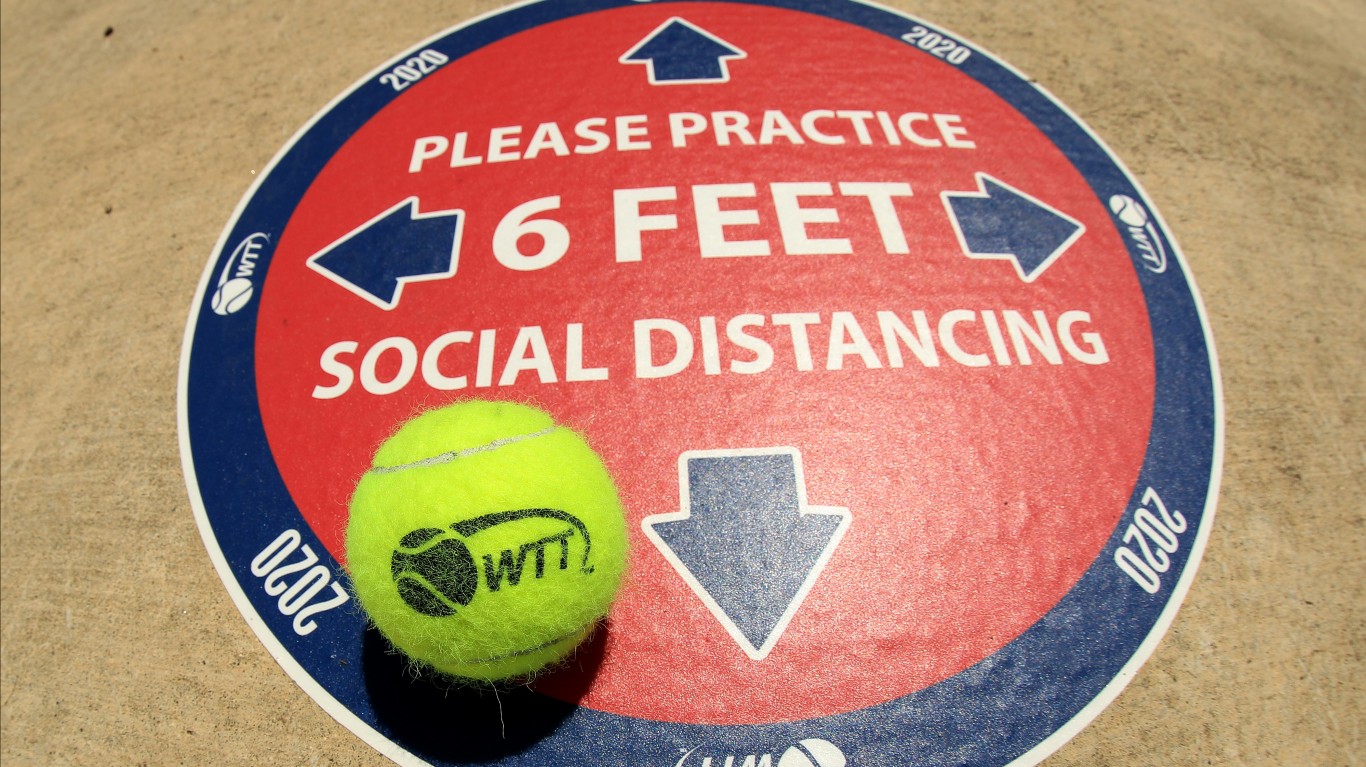

The world is more than eight months into the COVID-19 pandemic and still little is known about the novel coronavirus. With no vaccine or treatment or even full understanding of the way the virus is transmitted, social distancing has consistently been promoted — from the beginning — as the best available way to prevent further spread of the virus.
By now, most people are likely accustomed to keeping at least 6 feet apart, though perhaps other measures such as keeping the kids at home from school, not going to public events, and working from home are more difficult to get used to. Still, researchers from Massachusetts General Hospital have published a study showing that following social distancing guidelines is indeed an effective way to slow the spread.
According to the study, social distancing reduced the total number of COVID-19 cases by about 1,600 nationwide just a week after officials began implementing social distancing guidelines. Two weeks later, social distancing reduced the number of cases by about 55,000, and three weeks later by more than 620,000 cases.
24/7 Wall St. reviewed nationwide data from the study published in PLOS Medicine, a peer-reviewed weekly medical journal, to gauge the efficacy of social distancing measures.
Click here for each state’s outbreak before and after social distancing
Click here for our detailed methodology
The researchers caution that it is impossible to know exactly which social distancing measures — closing schools, capping gatherings, shutting down nonessential businesses, or issuing stay-at-home orders — worked the best as many states began closing around the same time in mid-March and some of the measures were used simultaneously.
Before any forms of social distancing were in place, the number of new COVID-19 cases in a state was doubling every 3.3 days on average. After three weeks of social distancing, the time it took for new cases to double slowed to 7.9 days on average.
In some states, the time it took for the number of total COVID-19 cases to double increased significantly in the three weeks since the first statewide social distancing measure was issued. In Washington state, for example, the doubling frequency went up from six days two weeks after implementation and to 46 days three weeks after implementation. A similarly big difference was noticed in seven more states.
On the other hand, the doubling frequency actually decreased in five states. This may be due to the fact that some states started to relax government-issued social distancing measures less than four weeks after mandating them, according to the study.
As of Aug. 27, nearly 5.9 million coronavirus cases have been reported across the U.S. since late January. While the spread of COVID-19 has begun to slow down after a resurgence in many states in June and July, daily new cases are still increasing in major metropolitan areas — here are the cities where the coronavirus is growing the fastest.
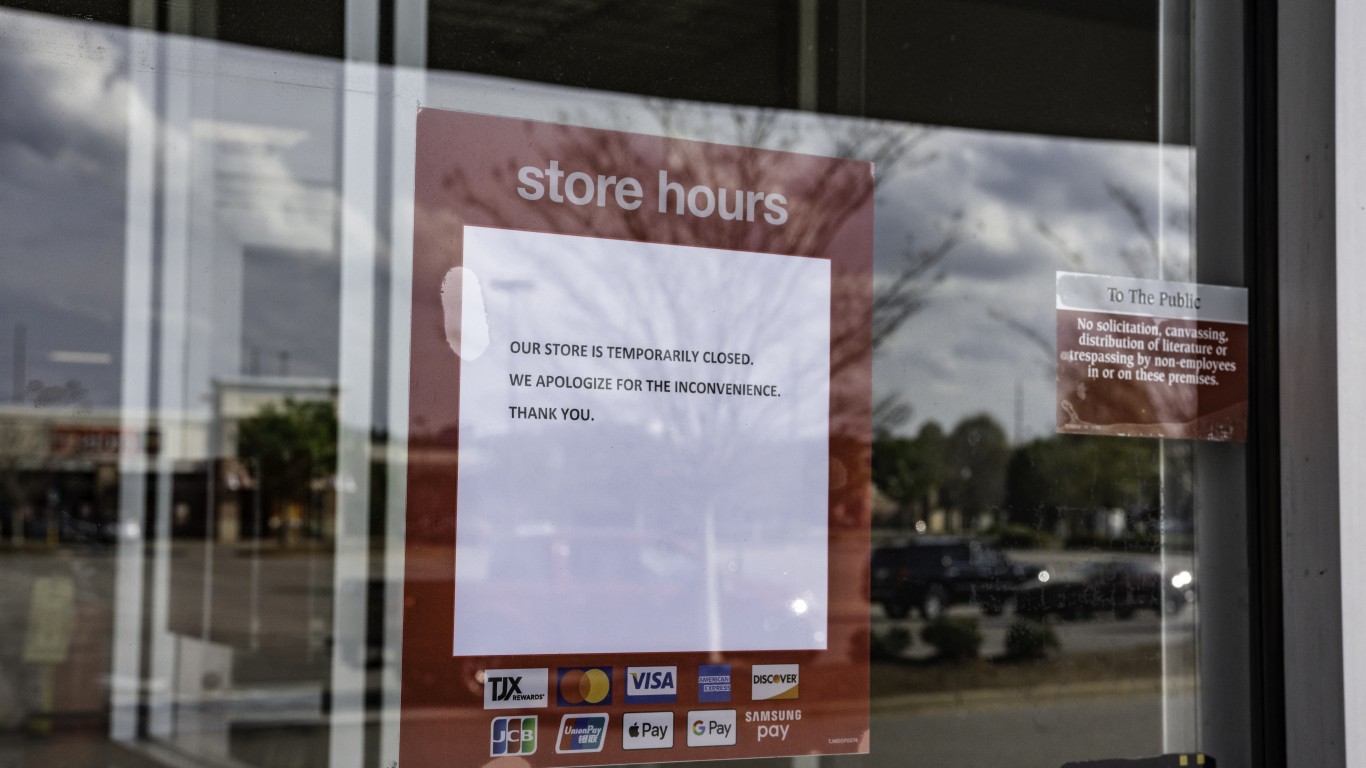
Alabama
> Date of first social distancing order: Mar 18, 2020
> Time for cases to double before first social distancing orders: 4 days
> Total cases as of Mar 18, 2020: 51
> Time for cases to double 7 days after: 2 days
> Time for cases to double 14 days after: 10 days
> Time for cases to double 21 days after: 8 days
> Total COVID-19 cases as of Aug. 27: 2,308 per 100,000 people — 6th highest (total: 112,794)
> Population: 4.9 million
Alabama closed schools on March 18, just a day before the governor ordered the cancellation of all public events. The order to close workplaces and have nonessential employees work from home followed on March 28. Though Alabama’s state borders remained open, beaches were closed and movement within the state was restricted.
[in-text-ad]
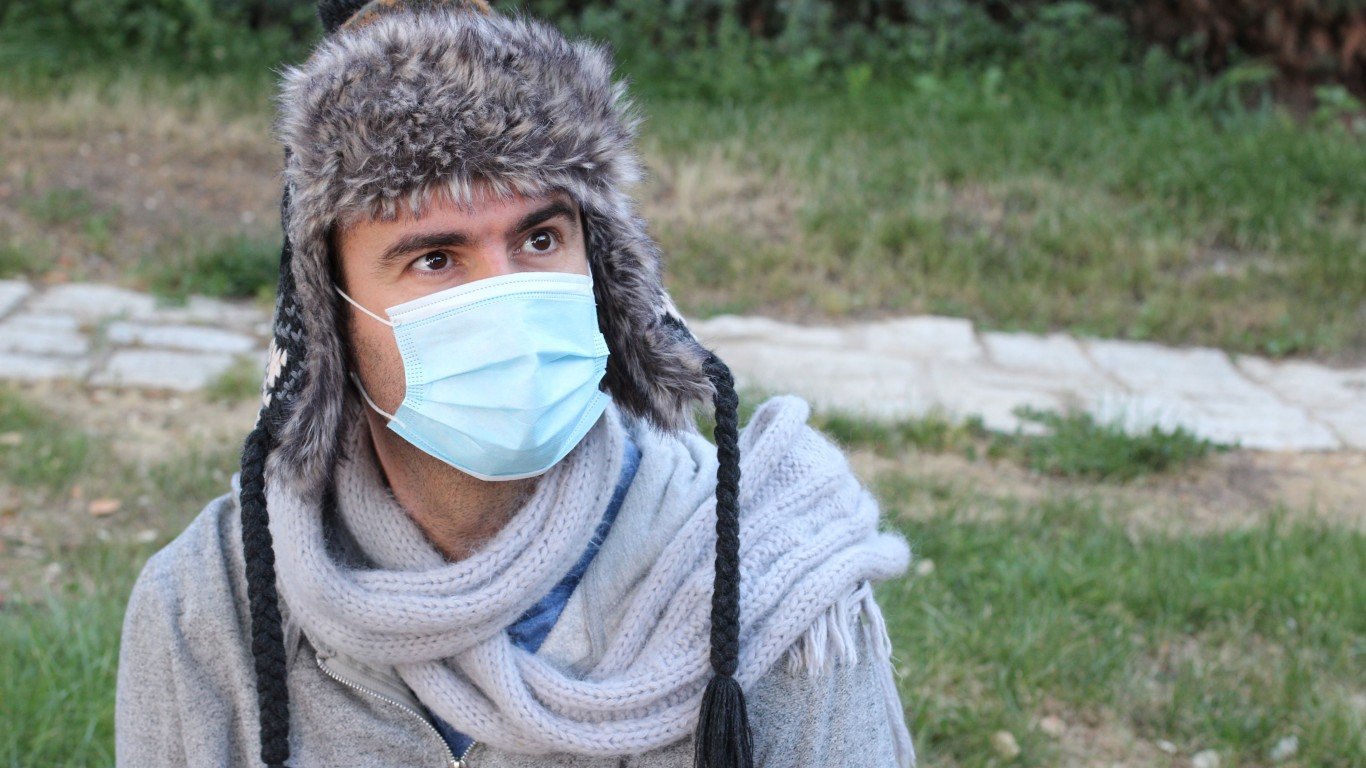
Alaska
> Date of first social distancing order: Mar 14, 2020
> Time for cases to double before first social distancing orders: N/A
> Total cases as of Mar 14, 2020: 1
> Time for cases to double 7 days after: 2 days
> Time for cases to double 14 days after: 5 days
> Time for cases to double 21 days after: 12 days
> Total COVID-19 cases as of Aug. 27: 787 per 100,000 people — 9th lowest (total: 5,801)
> Population: 737,000
Coronarius-related cancellations and closures began sweeping across the state mid-March. Alaska, the least densely-populated state, was one of the first states to close K-12 public schools. On March 13, Gov. Mike Dunleavy announced schools would cease in-person instruction between March 16-30, later extending that period until May and then until the rest of the school year. Annual events scheduled for March and April were canceled.
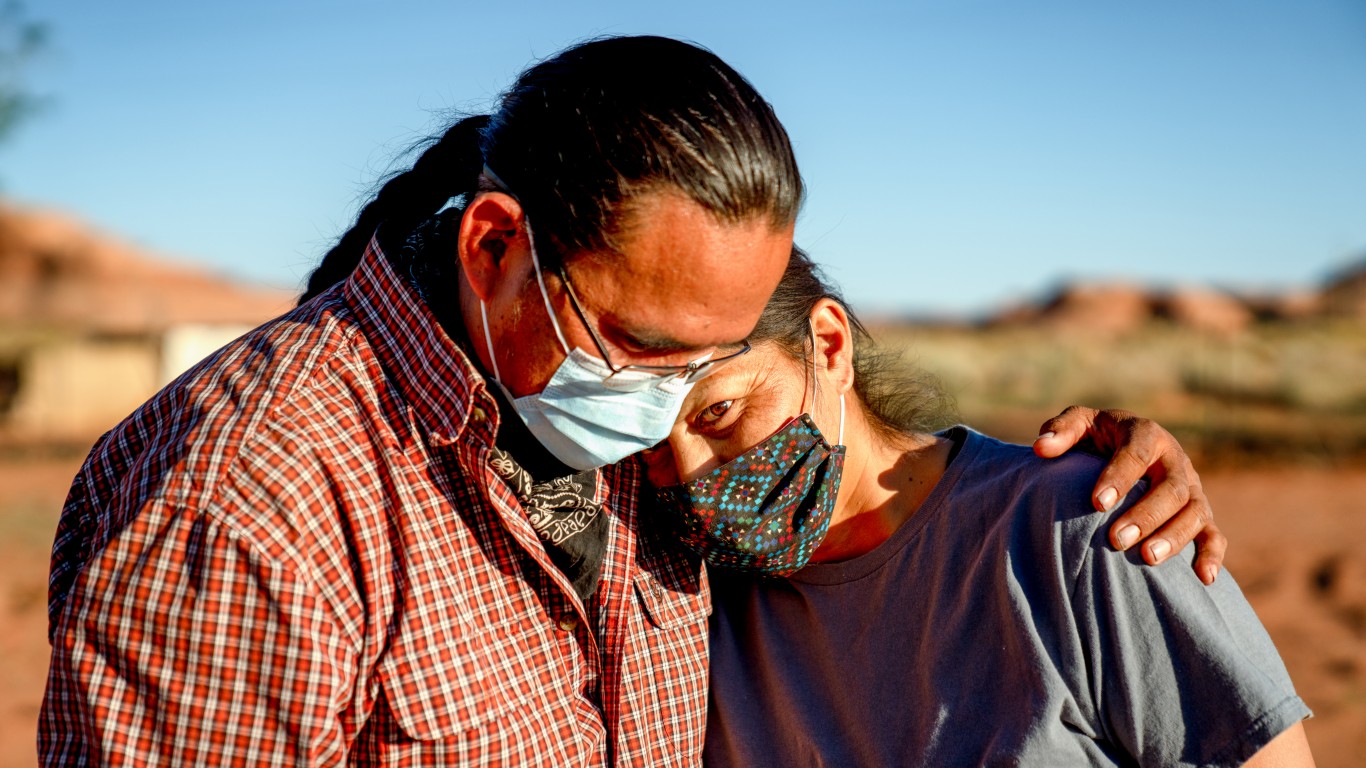
Arizona
> Date of first social distancing order: Mar 16, 2020
> Time for cases to double before first social distancing orders: 3 days
> Total cases as of Mar 16, 2020: 18
> Time for cases to double 7 days after: 2 days
> Time for cases to double 14 days after: 4 days
> Time for cases to double 21 days after: 12 days
> Total COVID-19 cases as of Aug. 27: 2,791 per 100,000 people — 3rd highest (total: 200,139)
> Population: 7.2 million
Arizona was one of 19 states that closed its borders for out-of-state visitors, doing so on April 9. This was approximately two weeks after ordering the closure of schools and workplaces for nonessential employees and the cancellation of all public events, as well as restricting social gatherings and other movements within the state.
Gov. Doug Ducey ordered the re-closing of bars, gyms, and movie theaters at the end of June due to a resurgence of new coronavirus cases in Arizona.
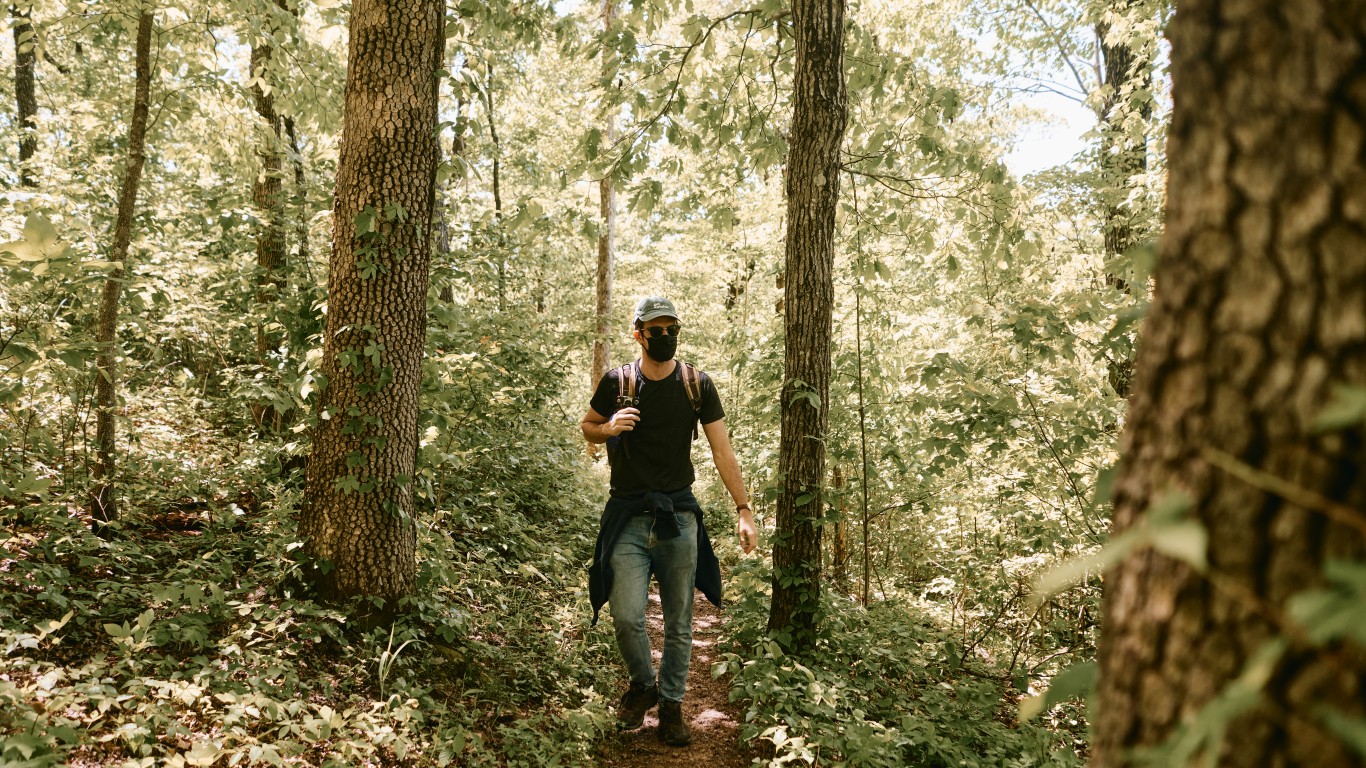
Arkansas
> Date of first social distancing order: Mar 19, 2020
> Time for cases to double before first social distancing orders: 2 days
> Total cases as of Mar 19, 2020: 62
> Time for cases to double 7 days after: 8 days
> Time for cases to double 14 days after: 11 days
> Time for cases to double 21 days after: 16 days
> Total COVID-19 cases as of Aug. 27: 1,949 per 100,000 people — 14th highest (total: 58,745)
> Population: 3.0 million
Arkansas closed schools and ordered all bars and restaurants to cease operations except for pickup and delivery on March 19, after coronavirus cases almost doubled overnight from 37 to 62. On March 23, the state’s Department of Health shut down salons and other personal service businesses. Though the state never issued a stay-at-home order, several cities and counties did.
[in-text-ad-2]
California
> Date of first social distancing order: Mar 11, 2020
> Time for cases to double before first social distancing orders: 8 days
> Total cases as of Mar 11, 2020: 202
> Time for cases to double 7 days after: 5 days
> Time for cases to double 14 days after: 5 days
> Time for cases to double 21 days after: 7 days
> Total COVID-19 cases as of Aug. 27: 1,728 per 100,000 people — 20th highest (total: 683,529)
> Population: 39.6 million
On March 11, 47 days after the first confirmed COVID-19 cases in the Golden State, Gov. Gavin Newsom recommended a limit on social gatherings. A few days later, organizers began canceling events and venues started to close. A couple of more days later, schools across the state closed, though temporarily at first. At the same time, senior home visits were restricted and a statewide stay-at-home order was issued.
In July, California started closing down again, first issuing restrictions on indoor dining and bars, due to a rapid increase in new COVID-19 cases in June and July.
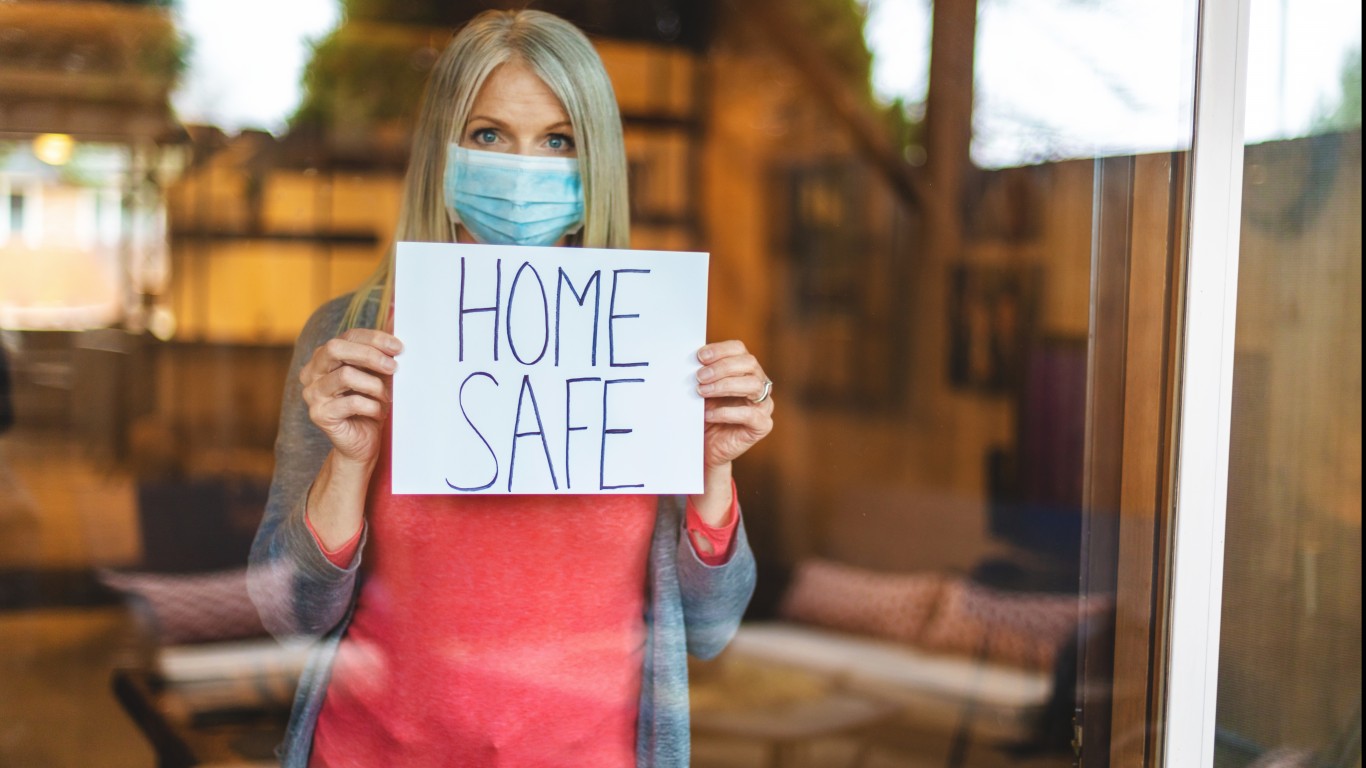
Colorado
> Date of first social distancing order: Mar 17, 2020
> Time for cases to double before first social distancing orders: 8 days
> Total cases as of Mar 17, 2020: 183
> Time for cases to double 7 days after: 4 days
> Time for cases to double 14 days after: 8 days
> Time for cases to double 21 days after: 21 days
> Total COVID-19 cases as of Aug. 27: 989 per 100,000 people — 11th lowest (total: 56,343)
> Population: 5.7 million
The first COVID-19 case in Colorado was confirmed on March 5. Within a week there were 49 cases, and a state of emergency was declared. By March 26, nonessential employees were ordered to work from home and schools were closed. Also, public events were canceled, and movement within the state was restricted.
On June 30, Colorado Gov. Jared Polis ordered bars and nightclubs to stop in-person service again after a spike in new coronavirus cases was traced back to such establishments.
[in-text-ad]

Connecticut
> Date of first social distancing order: Mar 12, 2020
> Time for cases to double before first social distancing orders: N/A
> Total cases as of Mar 12, 2020: 6
> Time for cases to double 7 days after: 2 days
> Time for cases to double 14 days after: 7 days
> Time for cases to double 21 days after: 14 days
> Total COVID-19 cases as of Aug. 27: 1,465 per 100,000 people — 25th highest (total: 52,350)
> Population: 3.6 million
Connecticut canceled all public events due to the coronavirus pandemic on March 11, one of the first states to do so. Not even two weeks later, on March 21, Gov. Ned Lamont issued an executive order closing nonessential businesses and requiring residents to stay home as much as possible as well as ordering people to work from home.
Delaware
> Date of first social distancing order: Mar 16, 2020
> Time for cases to double before first social distancing orders: N/A
> Total cases as of Mar 16, 2020: 9
> Time for cases to double 7 days after: 2 days
> Time for cases to double 14 days after: 8 days
> Time for cases to double 21 days after: 7 days
> Total COVID-19 cases as of Aug. 27: 1,755 per 100,000 people — 18th highest (total: 16,976)
> Population: 967,000
Delaware was one of 19 states that closed its state borders for visitors, doing so on March 30. By then, the state had already closed all public schools for in-person instruction, ordered nonessential employees to work from home, and canceled all public events. One of the first executive orders aimed at slowing the spread of COVID-19 was to close restaurants, issued March 16, except for takeout and delivery.
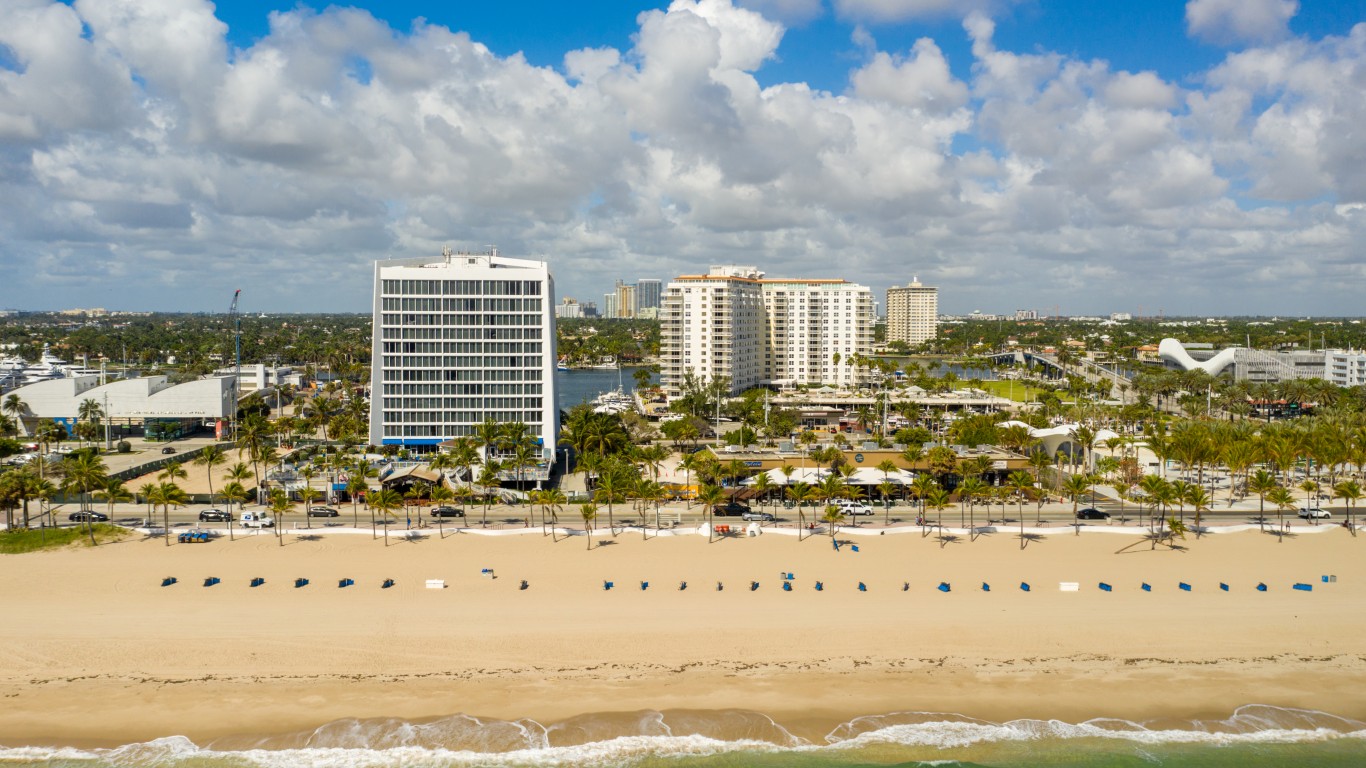
Florida
> Date of first social distancing order: Mar 16, 2020
> Time for cases to double before first social distancing orders: 4 days
> Total cases as of Mar 16, 2020: 141
> Time for cases to double 7 days after: 5 days
> Time for cases to double 14 days after: 7 days
> Time for cases to double 21 days after: 10 days
> Total COVID-19 cases as of Aug. 27: 2,873 per 100,000 people — 2nd highest (total: 611,991)
> Population: 21.3 million
Florida, a famous spring break destination, infamously did not cancel any of the events planned for the festival in early March. By then, the virus had started spreading in the state, and counties and cities had started issuing closing orders. By the end of the month, schools statewide and state borders were closed, and all public events were canceled.
At the end of July, Gov. Ron DeSantis was facing calls to close Florida again as the state became the new hotspot for the coronavirus after reopening.
[in-text-ad-2]
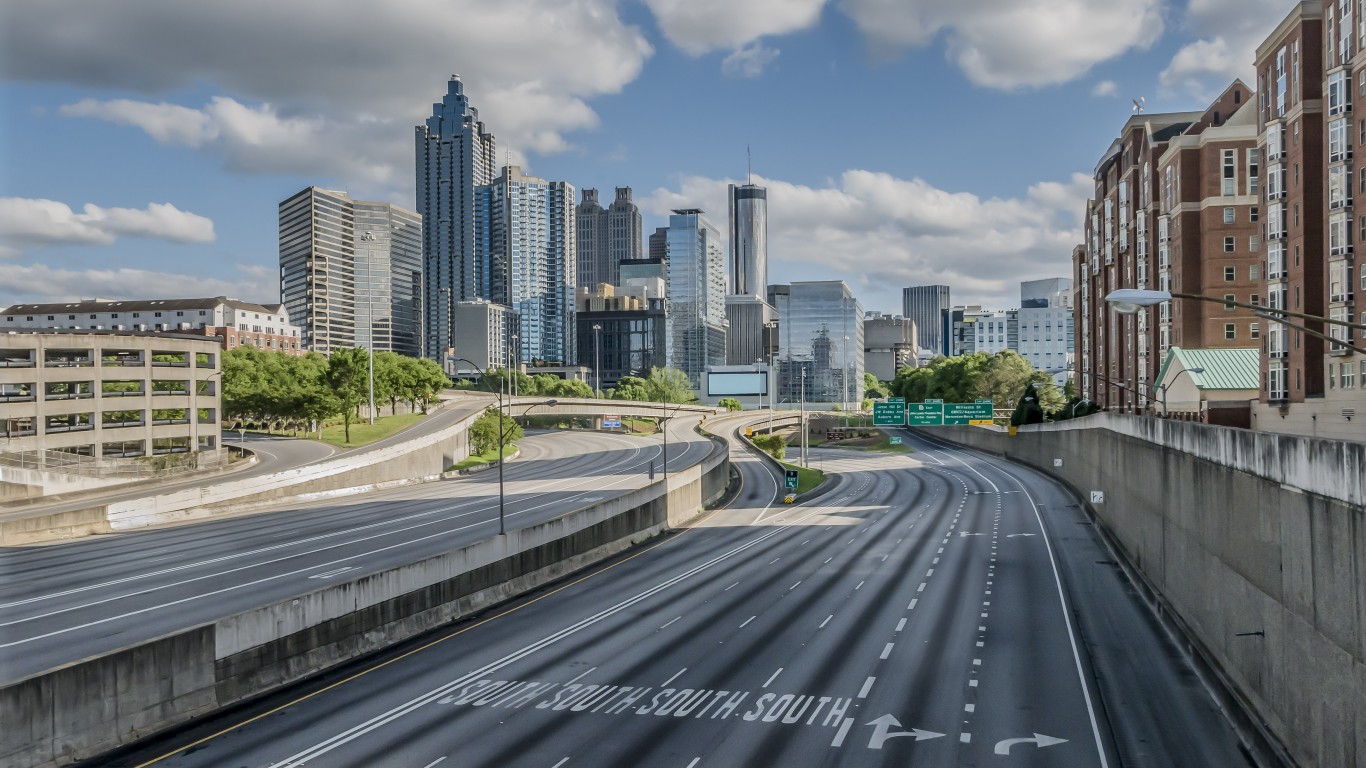
Georgia
> Date of first social distancing order: Mar 18, 2020
> Time for cases to double before first social distancing orders: 3 days
> Total cases as of Mar 18, 2020: 193
> Time for cases to double 7 days after: 4 days
> Time for cases to double 14 days after: 7 days
> Time for cases to double 21 days after: 9 days
> Total COVID-19 cases as of Aug. 27: 2,501 per 100,000 people — 5th highest (total: 263,074)
> Population: 10.5 million
Georgia closed schools on March 18 and canceled public events a week later. By April 3, nonessential employees were ordered to work from home and movement within the state was restricted. Social gatherings of more than 10 people were banned, and a curfew was imposed.
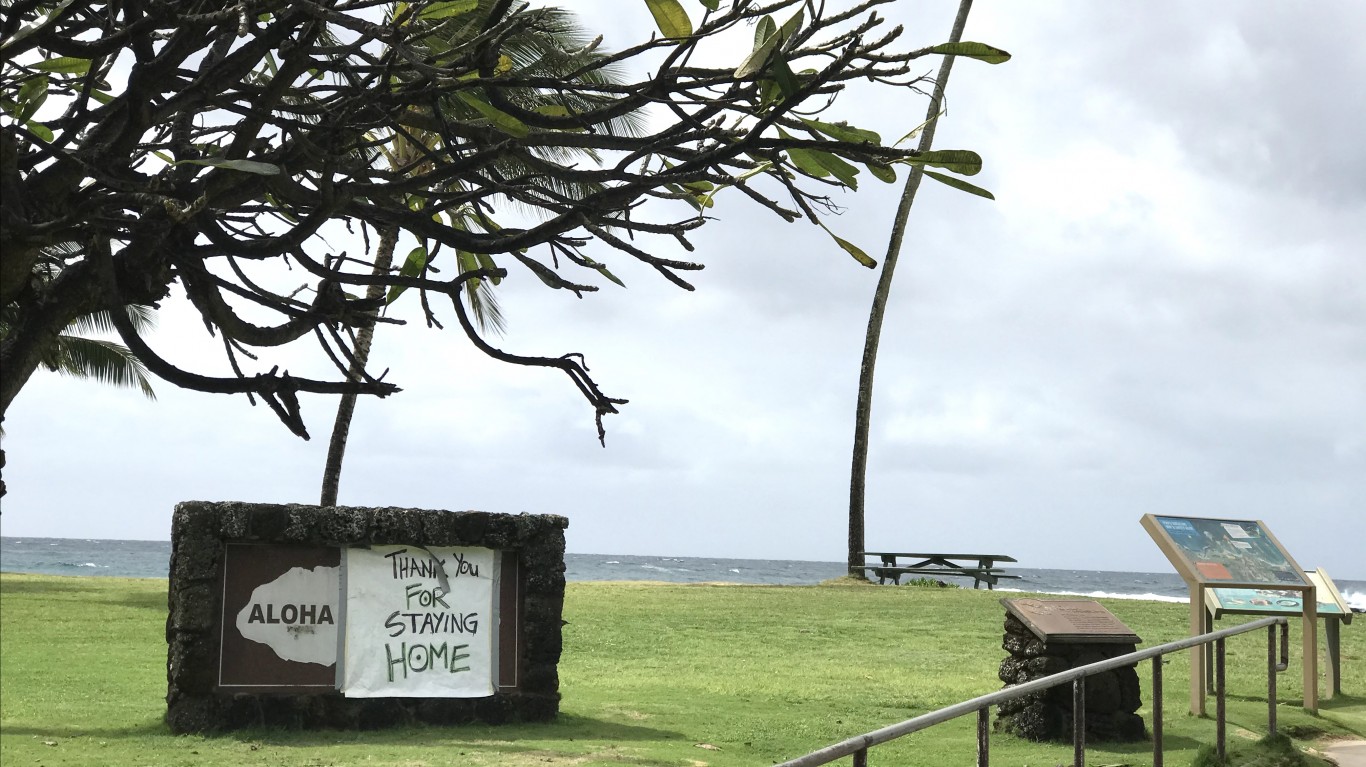
Hawaii
> Date of first social distancing order: Mar 15, 2020
> Time for cases to double before first social distancing orders: N/A
> Total cases as of Mar 15, 2020: 7
> Time for cases to double 7 days after: 6 days
> Time for cases to double 14 days after: 7 days
> Time for cases to double 21 days after: 18 days
> Total COVID-19 cases as of Aug. 27: 533 per 100,000 people — 4th lowest (total: 7,566)
> Population: 1.4 million
Hawaii was one of 19 states to not allow out-of-state visitors due to the coronavirus pandemic and one of the first states to close all schools for in-person instruction. By March 12, events were being canceled, and resorts had started to close.
More recently, on Aug. 26, after a surge in new coronavirus cases, Oahu, the state’s most populous island, ordered again all nonessential businesses to close and restaurants to stay open for takeout and delivery only for at least two weeks.
[in-text-ad]
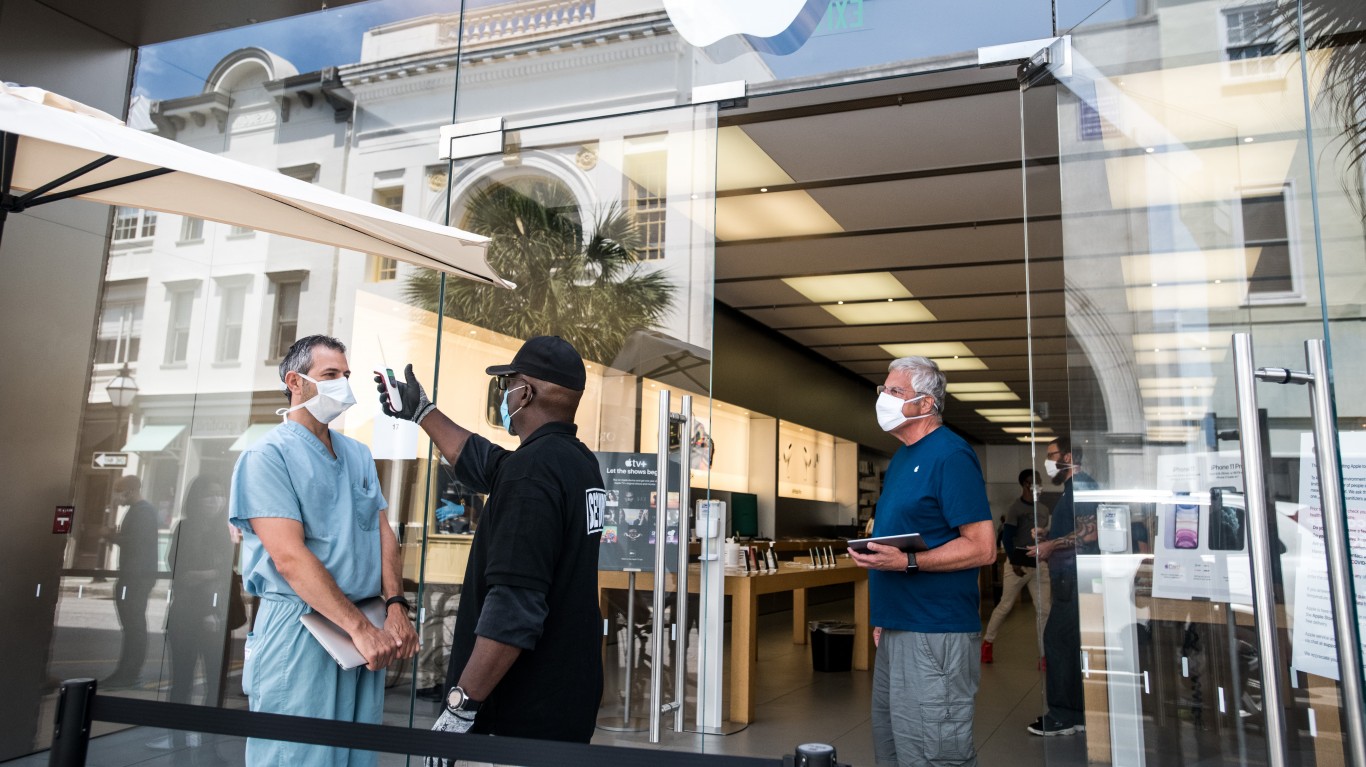
Idaho
> Date of first social distancing order: Mar 25, 2020
> Time for cases to double before first social distancing orders: 2 days
> Total cases as of Mar 25, 2020: 123
> Time for cases to double 7 days after: 4 days
> Time for cases to double 14 days after: 55 days
> Time for cases to double 21 days after: 32 days
> Total COVID-19 cases as of Aug. 27: 1,774 per 100,000 people — 17th highest (total: 31,122)
> Population: 1.8 million
Idaho ordered all public schools closed and nonessential employees to work from home on March 25, when 123 COVID-19 cases had been confirmed. Two days later, a statewide stay-at-home order was issued, significantly limiting people’s movements. The five-week executive order expired on April 30 and the state moved into its first phase of reopening.

Illinois
> Date of first social distancing order: Mar 13, 2020
> Time for cases to double before first social distancing orders: 3 days
> Total cases as of Mar 13, 2020: 46
> Time for cases to double 7 days after: 3 days
> Time for cases to double 14 days after: 6 days
> Time for cases to double 21 days after: 7 days
> Total COVID-19 cases as of Aug. 27: 1,784 per 100,000 people — 16th highest (total: 227,334)
> Population: 12.7 million
Illinois’ first social distancing order was issued on March 13, canceling all public events. A few days later, schools were closed, and nonessential employees were ordered to work from home. A stay-at-home order was issued on March 20, significantly restricting movement within the state.
After a resurgence in COVID-19 cases across the state, Illinois rolled out a $5 million campaign, encouraging mask use. The statewide mask mandate applies to people when they are outside as well. The order was recently tightened to require people in restaurants to wear masks when waiters are bringing their food.

Indiana
> Date of first social distancing order: Mar 16, 2020
> Time for cases to double before first social distancing orders: 4 days
> Total cases as of Mar 16, 2020: 24
> Time for cases to double 7 days after: 4 days
> Time for cases to double 14 days after: 6 days
> Time for cases to double 21 days after: 9 days
> Total COVID-19 cases as of Aug. 27: 1,352 per 100,000 people — 20th lowest (total: 90,504)
> Population: 6.7 million
On March 16, the day the first COVID-19-related death was confirmed in the state, Indiana closed bars and restaurants to in-person customers, and most schools had already either closed or switched to remote learning. On March 24, nonessential employees were ordered to work from home, and movement within the state was significantly restricted.
As a result of a resurgence of new coronavirus cases, the state delayed the new academic year and reimposed restrictions on businesses, including re-closing bars and nightclubs.
[in-text-ad-2]
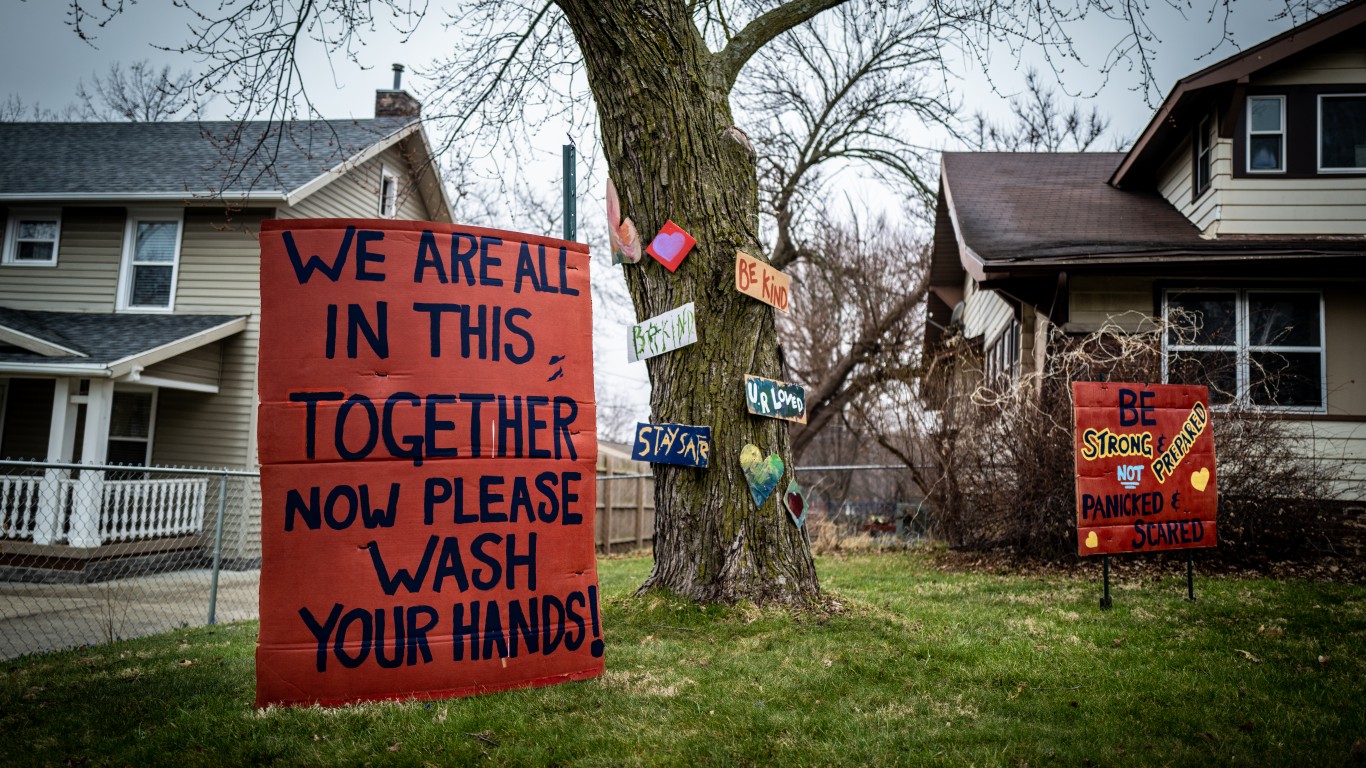
Iowa
> Date of first social distancing order: Mar 17, 2020
> Time for cases to double before first social distancing orders: 4 days
> Total cases as of Mar 17, 2020: 29
> Time for cases to double 7 days after: 6 days
> Time for cases to double 14 days after: 6 days
> Time for cases to double 21 days after: 10 days
> Total COVID-19 cases as of Aug. 27: 1,885 per 100,000 people — 15th highest (total: 59,496)
> Population: 3.2 million
Iowa was among the last states in the country to close schools, doing so on April 2. The state had already canceled all public events two weeks prior. Iowa never issued a stay-at-home order, though restrictions on businesses and movement were imposed.
Most recently, Gov. Kim Reynolds ordered bars in six counties in Iowa to close after the state recorded a new record high in daily COVID-19 cases.
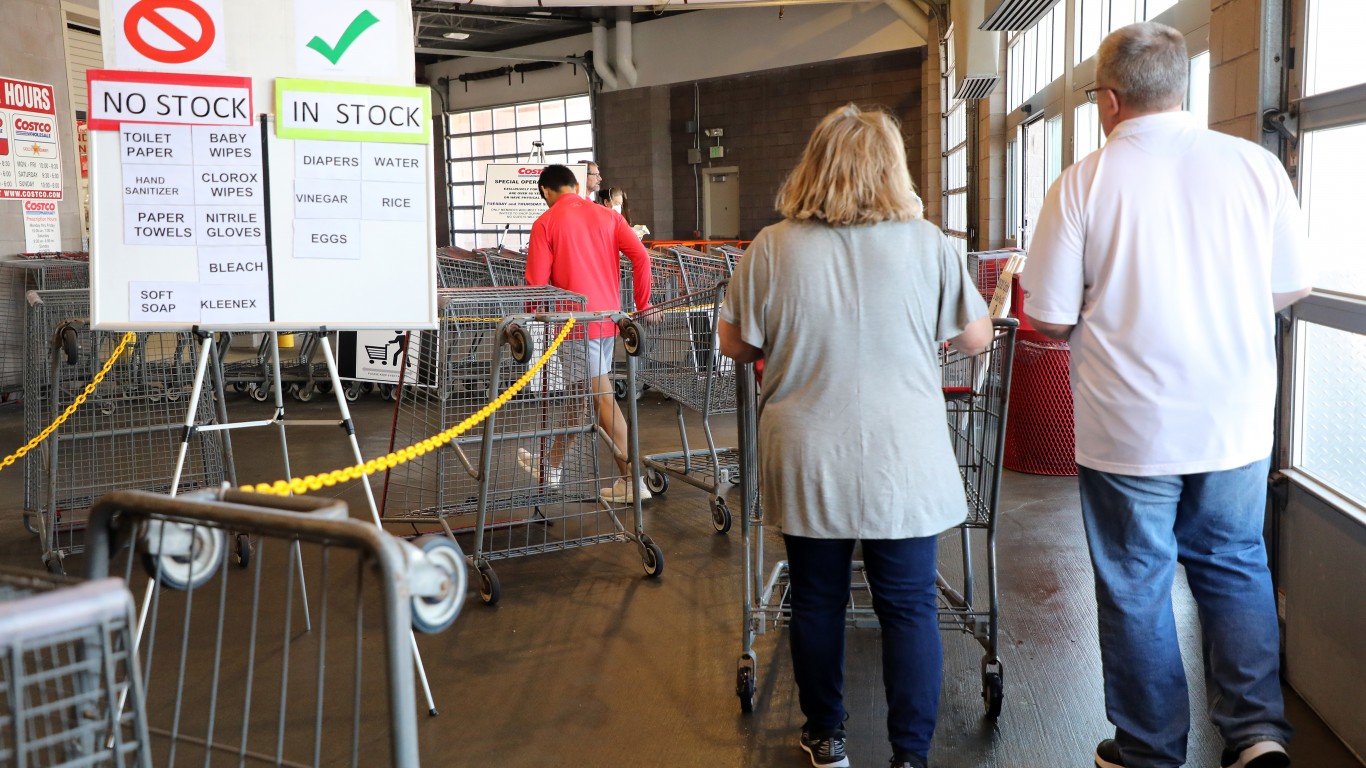
Kansas
> Date of first social distancing order: Mar 17, 2020
> Time for cases to double before first social distancing orders: 2 days
> Total cases as of Mar 17, 2020: 17
> Time for cases to double 7 days after: 5 days
> Time for cases to double 14 days after: 7 days
> Time for cases to double 21 days after: 17 days
> Total COVID-19 cases as of Aug. 27: 1,372 per 100,000 people — 22nd lowest (total: 39,937)
> Population: 2.9 million
Kansas declared a state of emergency on March 13, the day the first coronavirus-related death was confirmed in the state. Four days later, Gov. Laura Kelly ordered all schools to close for the remainder of the academic year. By the end of the month, all public events were canceled, the state borders were closed, and nonessential employees were directed to work from home.
[in-text-ad]
Kentucky
> Date of first social distancing order: Mar 18, 2020
> Time for cases to double before first social distancing orders: 3 days
> Total cases as of Mar 18, 2020: 35
> Time for cases to double 7 days after: 4 days
> Time for cases to double 14 days after: 8 days
> Time for cases to double 21 days after: 13 days
> Total COVID-19 cases as of Aug. 27: 1,029 per 100,000 people — 14th lowest (total: 45,978)
> Population: 4.5 million
Kentucky canceled all public events on March 18. Within a few days, Gov. Andy Beshear ordered all nonessential retail businesses as well as bars and restaurants to close except for takeout and delivery. Kentucky was one of 19 states that banned out-of-state visitors. The state closed its borders on March 30.
Due to a resurgence of COVID-19 cases in the state, at the end of July Beshear re-ordered all bars to close down and restaurants to reduce capacity again.
Louisiana
> Date of first social distancing order: Mar 13, 2020
> Time for cases to double before first social distancing orders: 1 day
> Total cases as of Mar 13, 2020: 36
> Time for cases to double 7 days after: 3 days
> Time for cases to double 14 days after: 6 days
> Time for cases to double 21 days after: 8 days
> Total COVID-19 cases as of Aug. 27: 3,125 per 100,000 people — the highest (total: 145,637)
> Population: 4.7 million
Louisiana was among the first states to close schools, on March 13, and to cancel public events, on March 17. A few days later, orders to stay at home as well as to work from home followed. Nonessential businesses were closed, and restaurants were restricted to takeout, drive-thru, and delivery only.
Louisiana has remained in phase 2 of reopening since the end of July, with social gatherings limited to 50 people and bars closing for on-premises consumption, due to a rise in new coronavirus cases across the state.
Maine
> Date of first social distancing order: Mar 18, 2020
> Time for cases to double before first social distancing orders: 3 days
> Total cases as of Mar 18, 2020: 43
> Time for cases to double 7 days after: 5 days
> Time for cases to double 14 days after: 8 days
> Time for cases to double 21 days after: 29 days
> Total COVID-19 cases as of Aug. 27: 330 per 100,000 people — 2nd lowest (total: 4,414)
> Population: 1.3 million
Maine was one of 19 states that closed its borders to visitors on April 3. The day before, all schools statewide were ordered to close (although many had already started to close temporarily). A week before that, workplaces were closed, and nonessential employees were ordered to work from home.
[in-text-ad-2]
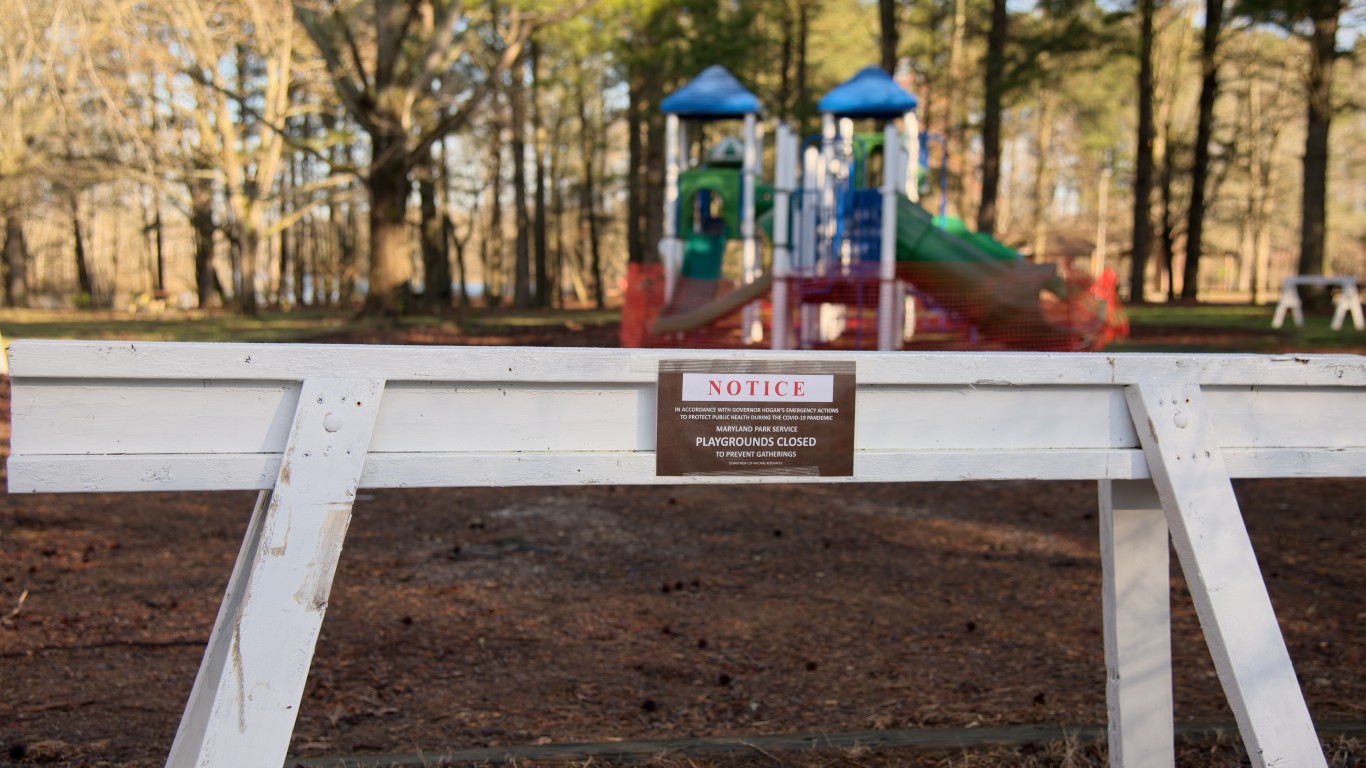
Maryland
> Date of first social distancing order: Mar 12, 2020
> Time for cases to double before first social distancing orders: N/A
> Total cases as of Mar 12, 2020: 12
> Time for cases to double 7 days after: 4 days
> Time for cases to double 14 days after: 3 days
> Time for cases to double 21 days after: 6 days
> Total COVID-19 cases as of Aug. 27: 1,755 per 100,000 people — 19th highest (total: 106,063)
> Population: 6.0 million
Maryland started canceling public events on March 12, one of the very first states to issue such an order in an attempt to slow the spread of the coronavirus. On March 16, the state closed schools. A week later, Gov. Larry Hogan ordered all nonessential employees to work from home and nonessential businesses to close. He issued a stay-at-home order on March 30.
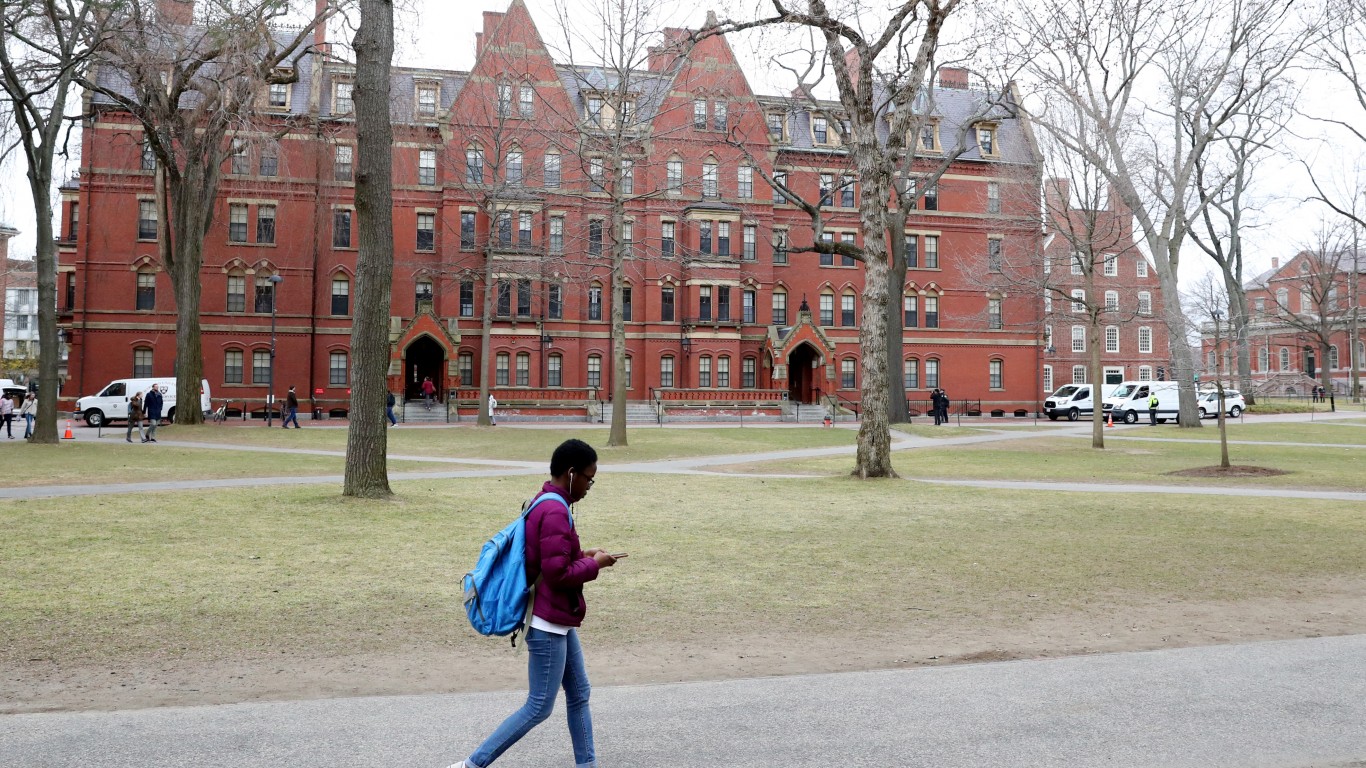
Massachusetts
> Date of first social distancing order: Mar 13, 2020
> Time for cases to double before first social distancing orders: 8 days
> Total cases as of Mar 13, 2020: 123
> Time for cases to double 7 days after: 4 days
> Time for cases to double 14 days after: 3 days
> Time for cases to double 21 days after: 7 days
> Total COVID-19 cases as of Aug. 27: 1,702 per 100,000 people — 22nd highest (total: 117,450)
> Population: 6.9 million
Massachusetts canceled public events in the state on March 13, closed schools on March 16, ordered all nonessential businesses to cease in-person operations on March 23, and ordered all nonessential employees to work from home on March 24. Massachusetts closed its borders for out-of-state visitors on March 27.
[in-text-ad]
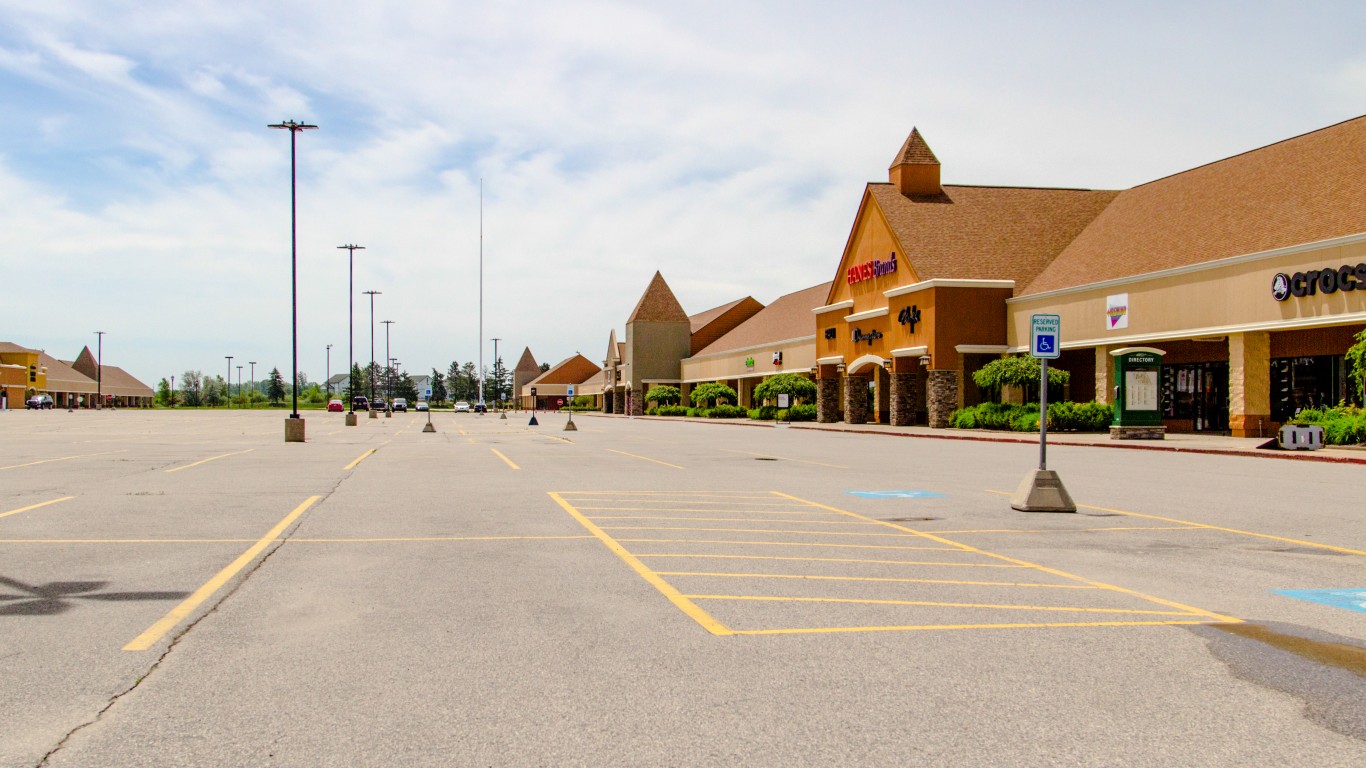
Michigan
> Date of first social distancing order: Mar 16, 2020
> Time for cases to double before first social distancing orders: 54 days
> Total cases as of Mar 16, 2020: 54
> Time for cases to double 7 days after: 4 days
> Time for cases to double 14 days after: 6 days
> Time for cases to double 21 days after: 11 days
> Total COVID-19 cases as of Aug. 27: 1,104 per 100,000 people — 15th lowest (total: 110,343)
> Population: 10.0 million
On March 16, six days after the first COVID-19 case was confirmed in the state, Gov. Gretchen Whitmer temporarily closed all K-12 schools. The same day Whitmer ordered bars and restaurants to close for in-person service and only stay open for takeout and delivery. Over the next few days, nonessential businesses such as gyms, spas, salons, and casinos, were shut, and social gatherings were capped to 50 people.
At the end of July, Whitmer reimposed restrictions in several counties in the Upper Peninsula, limiting indoor gatherings to 10 people and closing most bars.
Minnesota
> Date of first social distancing order: Mar 17, 2020
> Time for cases to double before first social distancing orders: 9 days
> Total cases as of Mar 17, 2020: 60
> Time for cases to double 7 days after: 9 days
> Time for cases to double 14 days after: 11 days
> Time for cases to double 21 days after: 12 days
> Total COVID-19 cases as of Aug. 27: 1,290 per 100,000 people — 18th lowest (total: 72,390)
> Population: 5.6 million
Minnesota canceled public events in the state on March 17, closed schools the next day, ordered nonessential employees to work from home on March 27, and issued a stay-at-home order also on March 27.
Bars and restaurants in Minneapolis, the most populous city in the state, were ordered to close again on July 29 in an effort to slow down the spread of the virus.
Mississippi
> Date of first social distancing order: Mar 19, 2020
> Time for cases to double before first social distancing orders: 3 days
> Total cases as of Mar 19, 2020: 50
> Time for cases to double 7 days after: 4 days
> Time for cases to double 14 days after: 11 days
> Time for cases to double 21 days after: 8 days
> Total COVID-19 cases as of Aug. 27: 2,702 per 100,000 people — 4th highest (total: 80,695)
> Population: 3.0 million
Mississippi issued its first social distancing order — closing all public schools — on March 19, when the state had 50 confirmed COVID-19 cases. Five days later, all public events were cancelled, followed by ordering nonessential employees to work from home and issuing a stay-at-home order.
Recently, in Jackson, Mississippi, bars were ordered to close again for indoor guests after a resurgence of new coronavirus cases.
[in-text-ad-2]
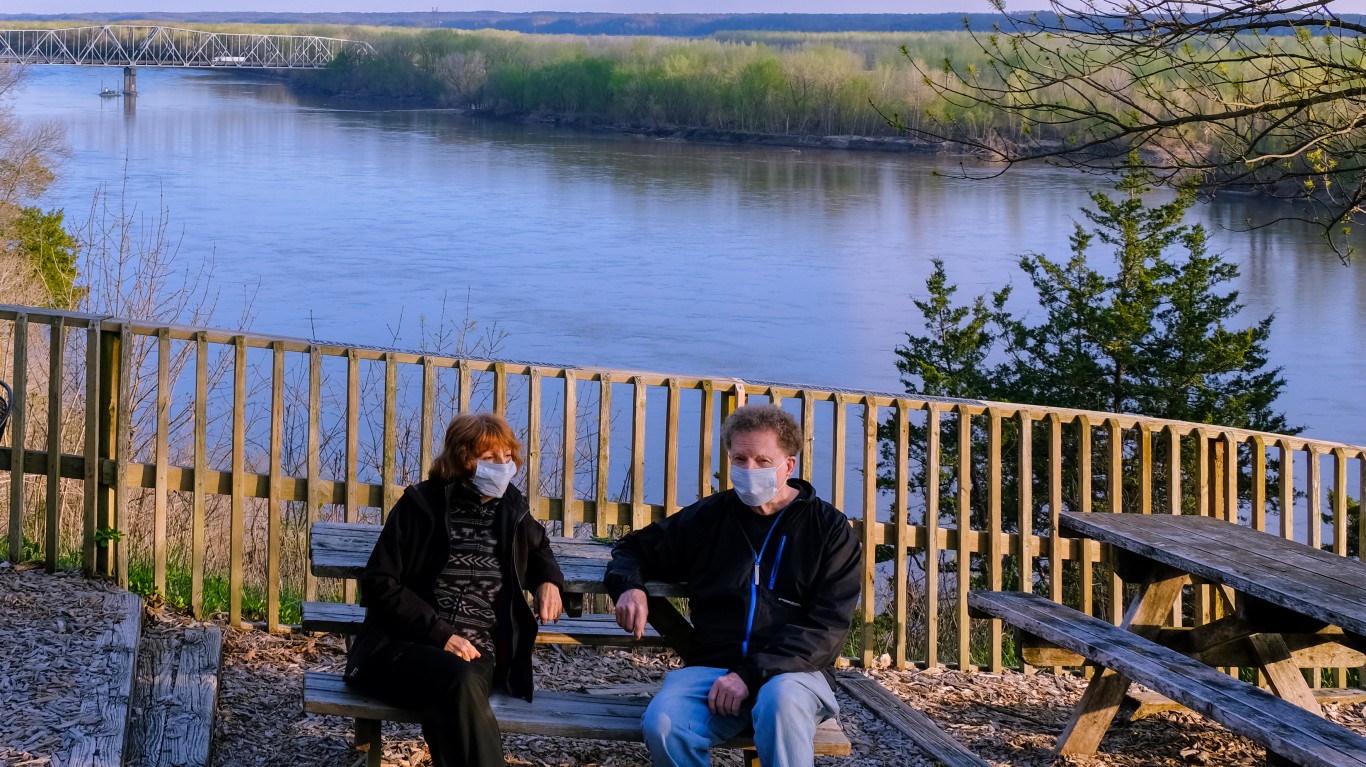
Missouri
> Date of first social distancing order: Mar 17, 2020
> Time for cases to double before first social distancing orders: 2 days
> Total cases as of Mar 17, 2020: 16
> Time for cases to double 7 days after: 3 days
> Time for cases to double 14 days after: 4 days
> Time for cases to double 21 days after: 9 days
> Total COVID-19 cases as of Aug. 27: 1,299 per 100,000 people — 19th lowest (total: 79,552)
> Population: 6.1 million
Missouri outlined guidelines on March 17, encouraging residents to avoid social gatherings of more than 50 people, use pick-up and drive-thru options at restaurants, and avoid discretionary travel and visits to nursing homes.
More recently, two of Missouri’s largest university campuses — the University of Missouri-Columbia and Missouri State University in Springfield — reported COVID-19 cases among returning students the week of Aug. 24. At University of Missouri-Columbia, 168 students tested positive, while Missouri State confirmed 140 cases of COVID-19.
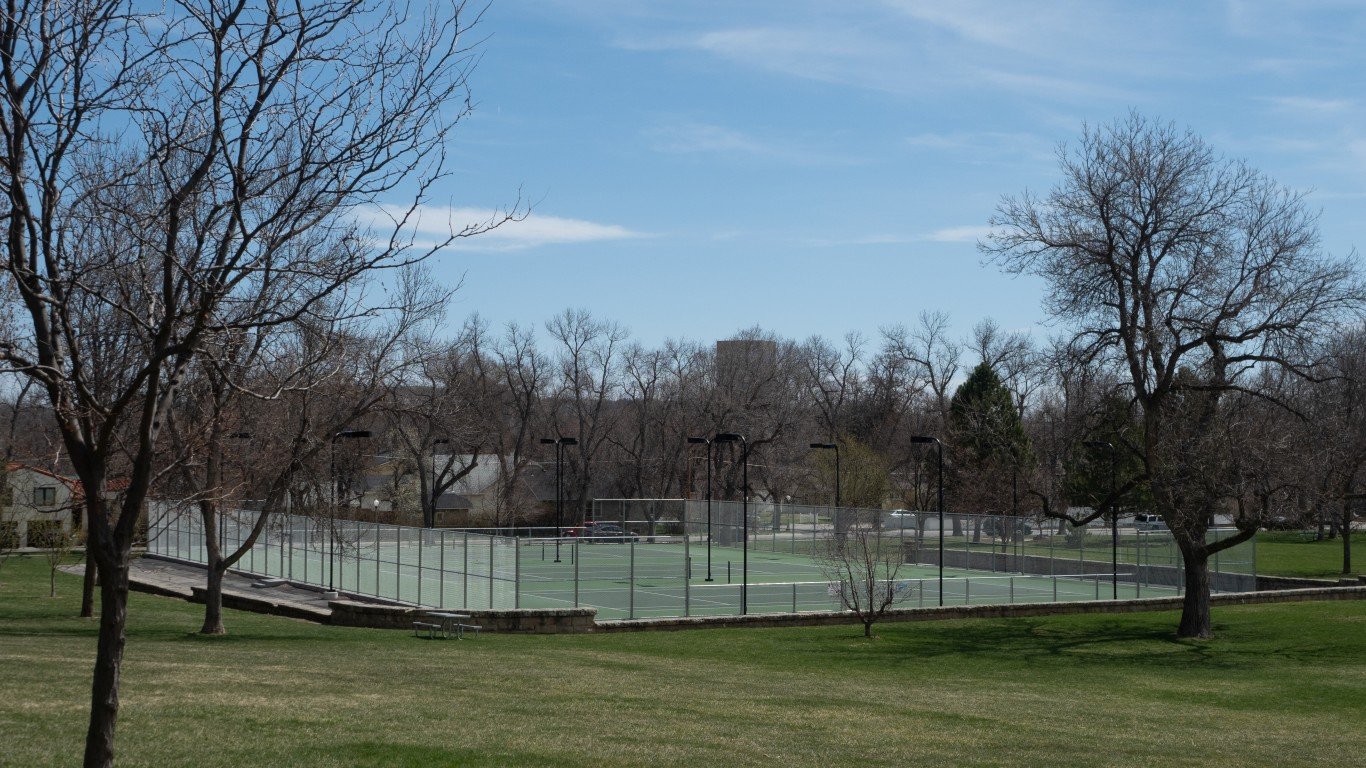
Montana
> Date of first social distancing order: Mar 16, 2020
> Time for cases to double before first social distancing orders: N/A
> Total cases as of Mar 16, 2020: 8
> Time for cases to double 7 days after: 4 days
> Time for cases to double 14 days after: 11 days
> Time for cases to double 21 days after: 15 days
> Total COVID-19 cases as of Aug. 27: 652 per 100,000 people — 8th lowest (total: 6,929)
> Population: 1.1 million
On March 15, Montana announced school closings, social distance rules, and limited nursing home visits. Gov. Steve Bullock recommended that gatherings of 50 or more people be limited, and that those over 60 years old not attend gatherings of more than 20 people. On Aug. 12, Bullock ordered people in public and private school buildings to wear face masks in counties with four or more active COVID-19 cases.
[in-text-ad]
Nebraska
> Date of first social distancing order: Mar 16, 2020
> Time for cases to double before first social distancing orders: 16 days
> Total cases as of Mar 16, 2020: 33
> Time for cases to double 7 days after: 6 days
> Time for cases to double 14 days after: 3 days
> Time for cases to double 21 days after: 7 days
> Total COVID-19 cases as of Aug. 27: 1,716 per 100,000 people — 21st highest (total: 33,101)
> Population: 1.9 million
Nebraska was one of seven states that did not issue stay-at-home orders in March and April. The other states were Arkansas, Iowa, North Dakota, South Dakota, Utah, and Wyoming. The state did not issue mask-wearing requirements. Gov. Pete Ricketts issued a public order on March 16 limiting events and gatherings to 50 people.
On April 24, Ricketts announced that certain restrictions on gatherings and business operations will be loosened regionally starting May 4. Non-contact team sports for youth and adults were allowed to resume practices on June 1 and games on June 18.
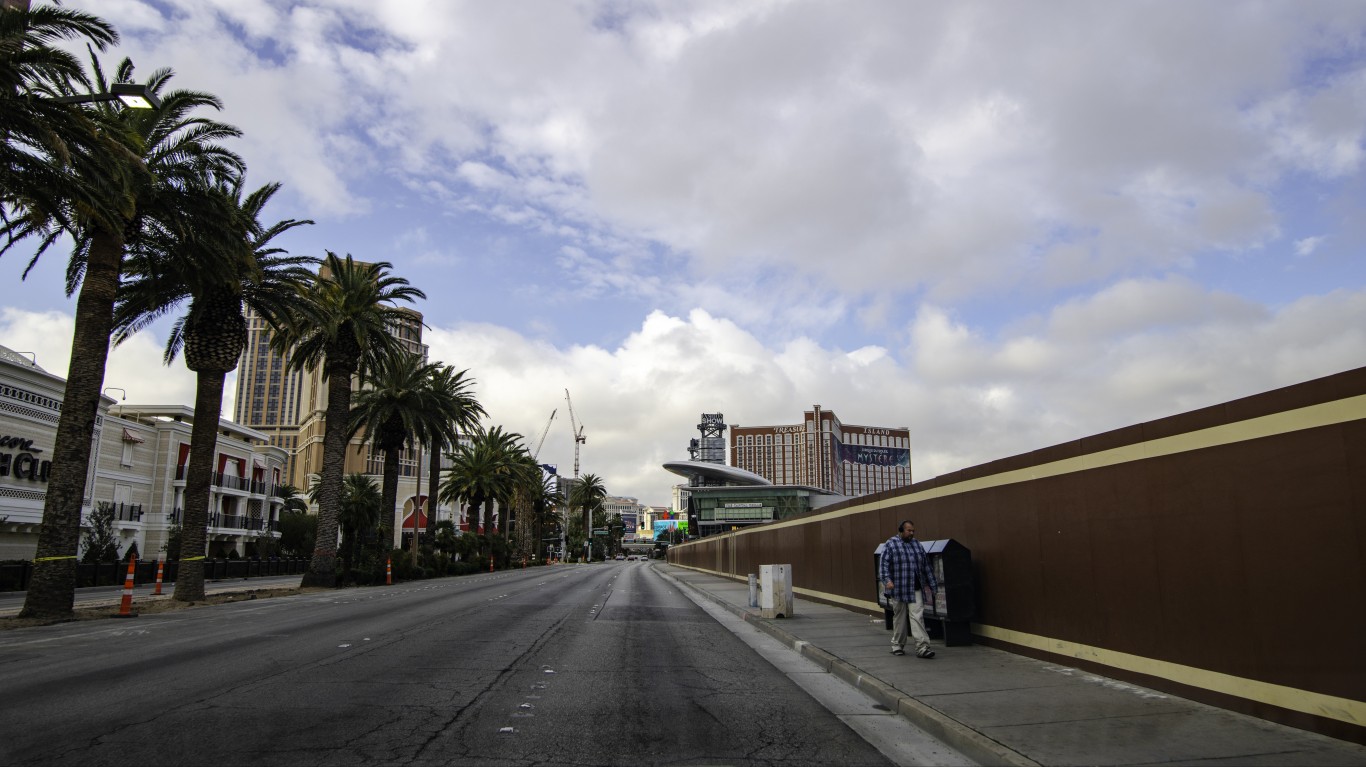
Nevada
> Date of first social distancing order: Mar 16, 2020
> Time for cases to double before first social distancing orders: 2 days
> Total cases as of Mar 16, 2020: 45
> Time for cases to double 7 days after: 3 days
> Time for cases to double 14 days after: 8 days
> Time for cases to double 21 days after: 21 days
> Total COVID-19 cases as of Aug. 27: 2,215 per 100,000 people — 8th highest (total: 67,220)
> Population: 3.0 million
Nevada, whose economy depends a great deal on the hospitality sector, was forced to close hotels and casinos on March 17. In July, some hotels remained closed while casinos reopened, though not at full capacity, and without entertainment. With restrictions in place and customers wary about returning, casino revenue on the Las Vegas Strip fell 39% to $330.1 million in July from the same month a year ago, according to Bloomberg.
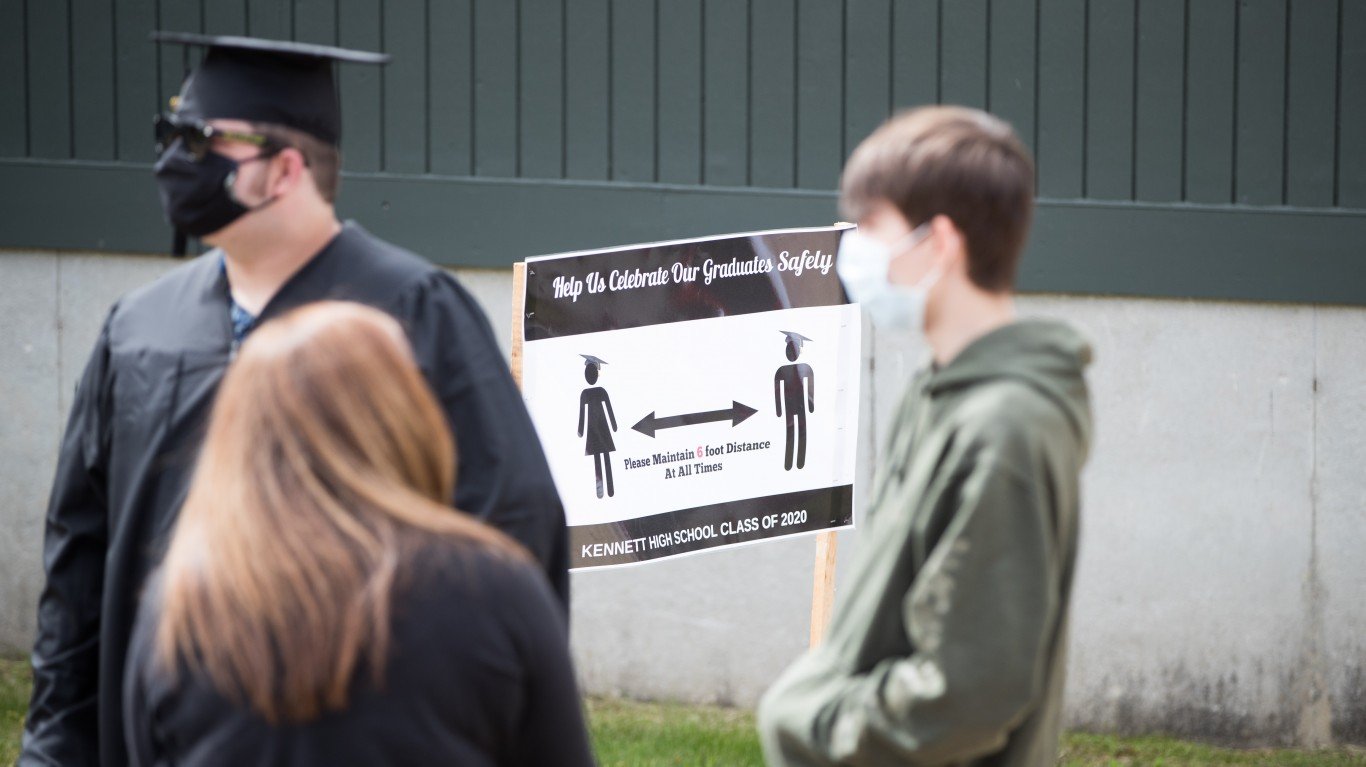
New Hampshire
> Date of first social distancing order: Mar 16, 2020
> Time for cases to double before first social distancing orders: 4 days
> Total cases as of Mar 16, 2020: 17
> Time for cases to double 7 days after: 4 days
> Time for cases to double 14 days after: 5 days
> Time for cases to double 21 days after: 15 days
> Total COVID-19 cases as of Aug. 27: 530 per 100,000 people — 3rd lowest (total: 7,194)
> Population: 1.4 million
On March 15, New Hampshire prohibited visitors to residential care for elderly or infirm patients with some exceptions. That same day, Gov. Christopher Sununu declared a state of emergency, which has been extended seven times.
New Hampshire has reported 430 deaths attributed to COVID-19 as of Aug. 27, one of the lower fatality totals for any state, and the Granite State is trying to keep its guard up. Earlier this month, health officials in New Hampshire said six residents who attended the motorcycle rally in South Dakota tested positive for COVID-19.
[in-text-ad-2]
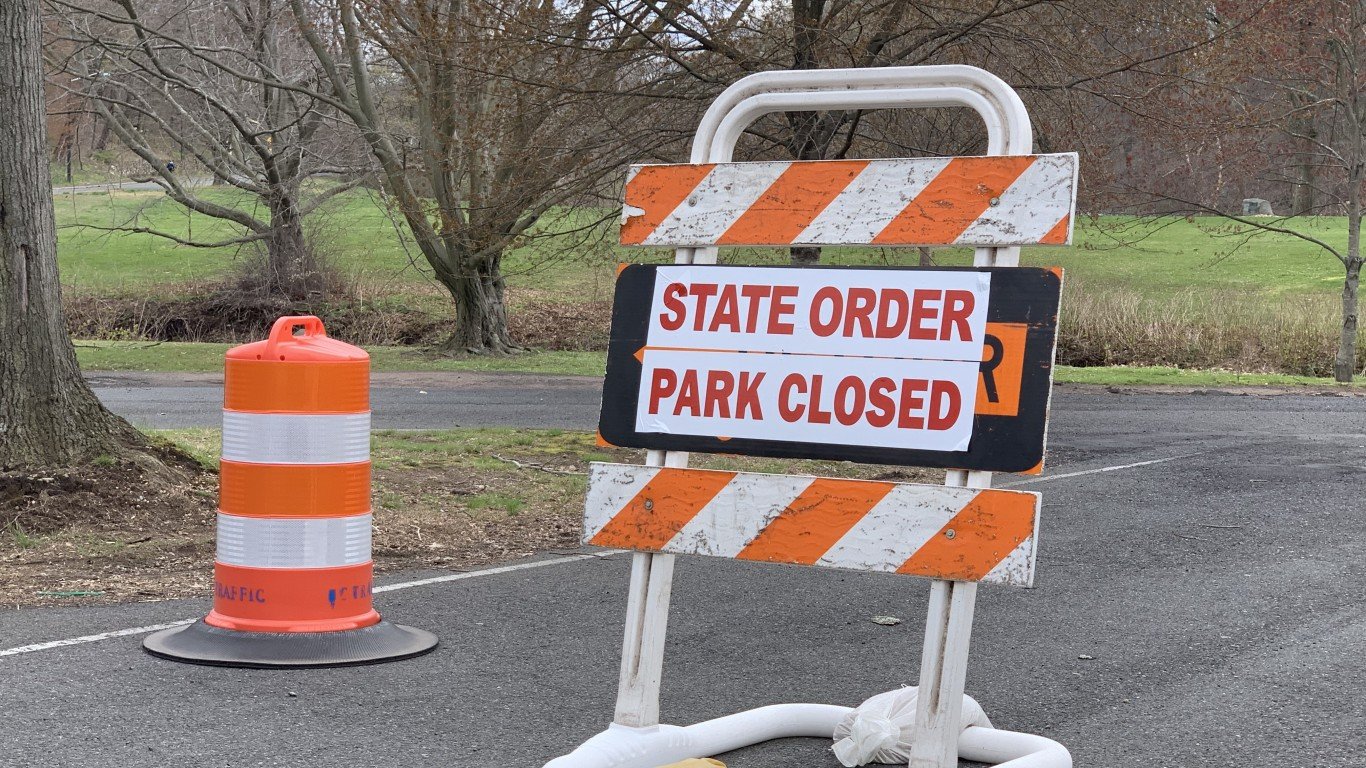
New Jersey
> Date of first social distancing order: Mar 16, 2020
> Time for cases to double before first social distancing orders: 2 days
> Total cases as of Mar 16, 2020: 176
> Time for cases to double 7 days after: 3 days
> Time for cases to double 14 days after: 5 days
> Time for cases to double 21 days after: 11 days
> Total COVID-19 cases as of Aug. 27: 2,140 per 100,000 people — 11th highest (total: 190,613)
> Population: 8.9 million
New Jersey, the most densely populated state, has had the second-most fatalities of any state at more than 15,000 as of Aug. 27, and imposed some of the nation’s strictest lockdown orders. Indoor concert venues, movie theaters, indoor amusement parks, and indoor dining are closed.
The worst of the epidemic appears, at least so far, to have passed in New Jersey. Beginning Sept. 1, indoor amusement facilities and gyms may reopen at 25% capacity if they adhere to health and social distancing protocols.

New Mexico
> Date of first social distancing order: Mar 16, 2020
> Time for cases to double before first social distancing orders: 5 days
> Total cases as of Mar 16, 2020: 21
> Time for cases to double 7 days after: 4 days
> Time for cases to double 14 days after: 6 days
> Time for cases to double 21 days after: 11 days
> Total COVID-19 cases as of Aug. 27: 1,189 per 100,000 people — 16th lowest (total: 24,920)
> Population: 2.1 million
New Mexico had a surge in COVID-19 cases between Memorial Day and July Fourth. As Labor Day approaches, New Mexico health officials are asking people to avoid large gatherings at their homes to reduce the risk of spike in cases.
[in-text-ad]
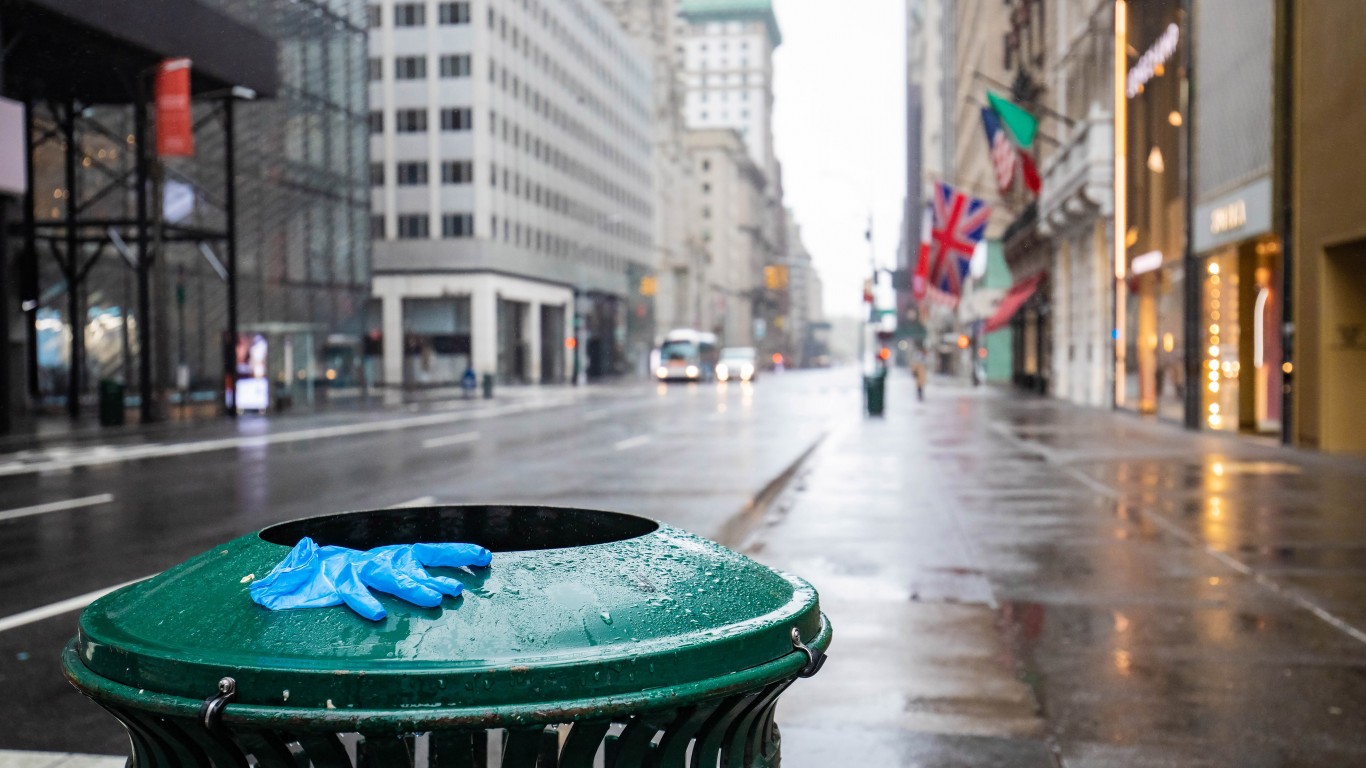
New York
> Date of first social distancing order: Mar 16, 2020
> Time for cases to double before first social distancing orders: 4 days
> Total cases as of Mar 16, 2020: 950
> Time for cases to double 7 days after: 3 days
> Time for cases to double 14 days after: 8 days
> Time for cases to double 21 days after: 16 days
> Total COVID-19 cases as of Aug. 27: 2,211 per 100,000 people — 9th highest (total: 432,131)
> Population: 19.5 million
New York, the epicenter of the pandemic in the U.S. in March and April, recorded more than 32,000 fatalities attributed to COVID-19, the most of any state. Gov. Andrew Cuomo issued on March 16 orders that canceled any event that would draw 50 people or more, and closed restaurants, bars, gyms, and movie theaters until further notice. Cuomo announced on July 1 that the reopening of indoor dining in New York City, initially scheduled during phase 3 of reopening, was postponed. The U.S. Open tennis tournament will be held in Mamaroneck from Sept. 13 to Sept. 20 without fans.
New York has begun reopening and moved to the fourth phase of its reopening plan on July 20. Nonessential businesses are allowed to reopen in certain regions.
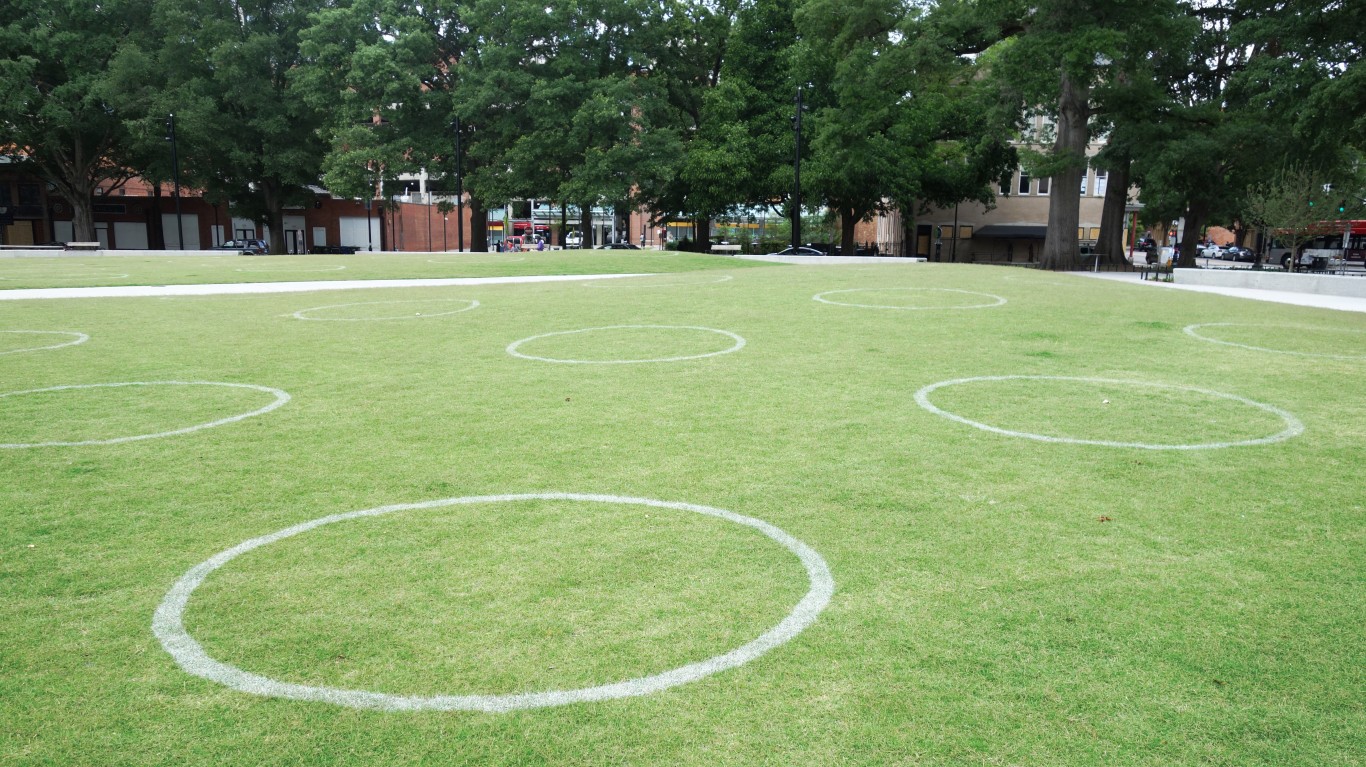
North Carolina
> Date of first social distancing order: Mar 16, 2020
> Time for cases to double before first social distancing orders: 16 days
> Total cases as of Mar 16, 2020: 34
> Time for cases to double 7 days after: 9 days
> Time for cases to double 14 days after: 9 days
> Time for cases to double 21 days after: 10 days
> Total COVID-19 cases as of Aug. 27: 1,551 per 100,000 people — 24th highest (total: 161,076)
> Population: 10.4 million
Gov. Ray Cooper issued an executive order limiting mass gatherings in North Carolina to 100 people in one room and closed all public schools, effective March 16. COVID-19 outbreaks in early August at schools at North Carolina have forced universities in the Tar Heel State to rethink or delay in-person classes. The University of North Carolina at Chapel Hill has shifted to remote instruction only. North Carolina State had to close dorms following reports of positive cases. East Carolina University announced it was going online. UNC-Charlotte said it would delay in-person classes and housing for students until Oct. 1.
North Dakota
> Date of first social distancing order: Mar 16, 2020
> Time for cases to double before first social distancing orders: N/A
> Total cases as of Mar 16, 2020: 1
> Time for cases to double 7 days after: 15 days
> Time for cases to double 14 days after: 9 days
> Time for cases to double 21 days after: 12 days
> Total COVID-19 cases as of Aug. 27: 1,421 per 100,000 people — 25th lowest (total: 10,800)
> Population: 760,000
North Dakota declared a state of emergency on March 15 and closed all public schools that day. The state was one of seven that never issued a statewide lockdown order. As of Aug. 24, the North Dakota Department of Health had identified 17 people infected with COVID-19 who attended or were associated with someone who had attended the Sturgis Motorcycle Rally in the state.
[in-text-ad-2]
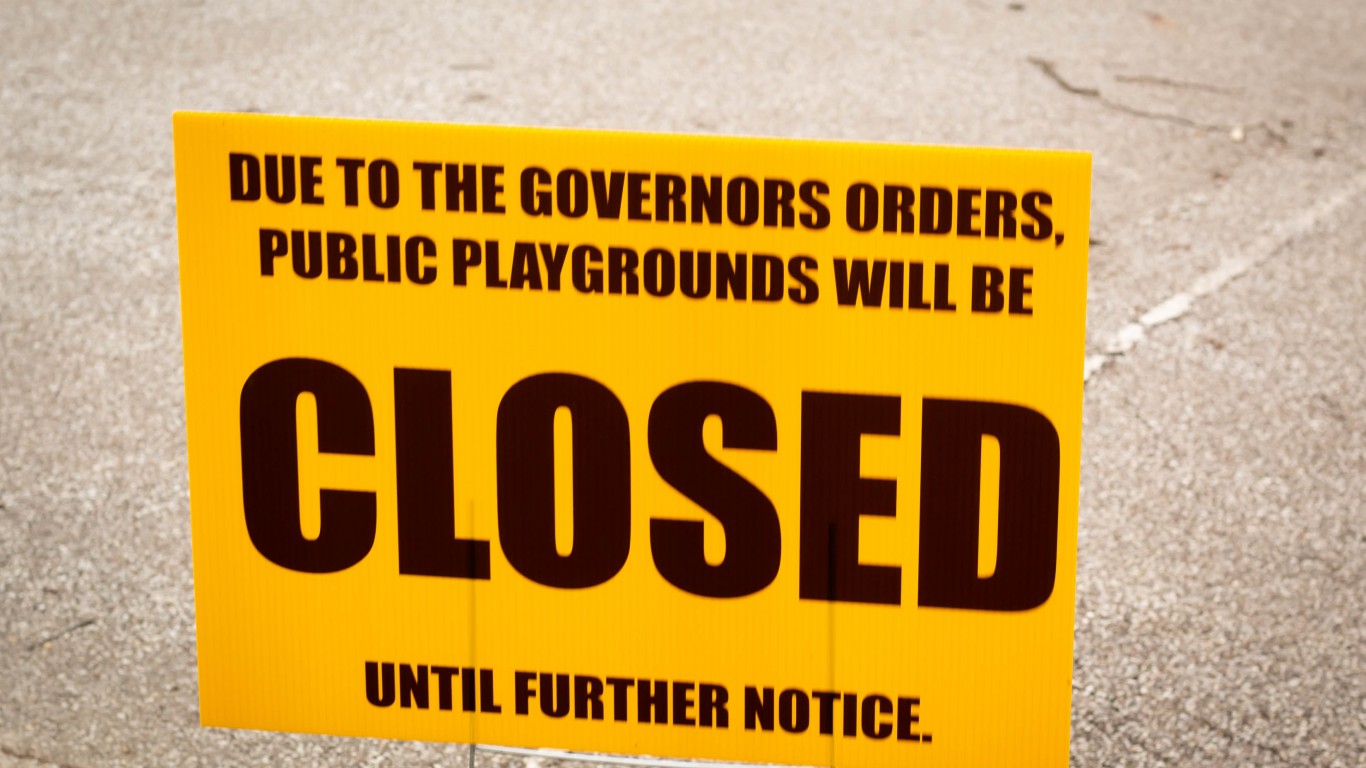
Ohio
> Date of first social distancing order: Mar 15, 2020
> Time for cases to double before first social distancing orders: 3 days
> Total cases as of Mar 15, 2020: 37
> Time for cases to double 7 days after: 3 days
> Time for cases to double 14 days after: 6 days
> Time for cases to double 21 days after: 13 days
> Total COVID-19 cases as of Aug. 27: 1,017 per 100,000 people — 12th lowest (total: 118,828)
> Population: 11.7 million
Ohio Gov. Mike DeWine was the first governor in the nation to public schools — on March 12. He extended school closures through the rest of the academic year on April 20. DeWine has also taken a relatively measured approach to reopening the economy, extending stay at home orders beyond those of neighboring states and drawing criticism for requiring all Ohioans to wear masks in public. The Ohio State Fair, originally scheduled to run July 29 through Aug. 9, was canceled.
Oklahoma
> Date of first social distancing order: Mar 17, 2020
> Time for cases to double before first social distancing orders: 2 days
> Total cases as of Mar 17, 2020: 18
> Time for cases to double 7 days after: 4 days
> Time for cases to double 14 days after: 6 days
> Time for cases to double 21 days after: 10 days
> Total COVID-19 cases as of Aug. 27: 1,409 per 100,000 people — 24th lowest (total: 55,550)
> Population: 3.9 million
Oklahoma closed its public schools on March 17, the day it issued its first social distancing order, with the intention of reopening on April 7. The order was then amended on March 25 for schools to remain closed the rest of the year. In late April, Oklahoma was among the first states to loosen its lockdown orders, allowing salons, spas, and barbershops to reopen.
[in-text-ad]
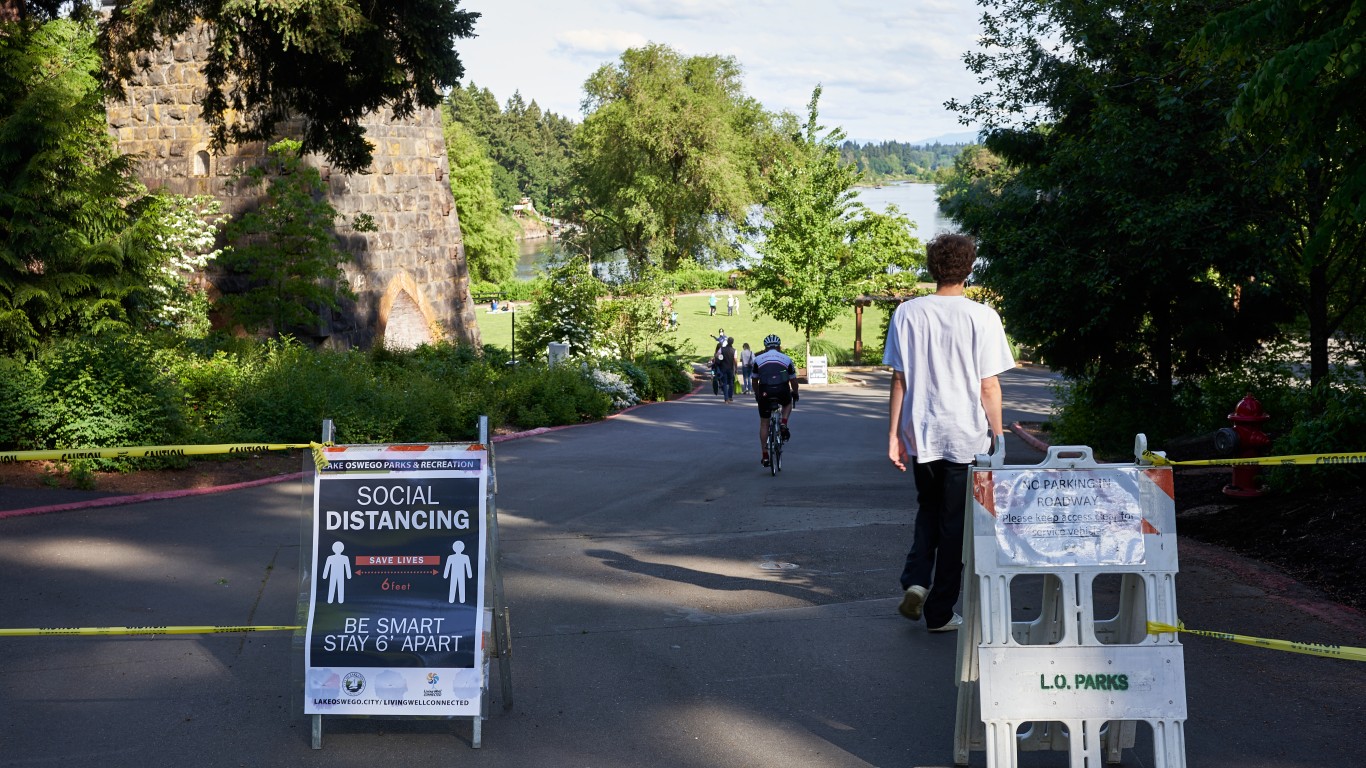
Oregon
> Date of first social distancing order: Mar 16, 2020
> Time for cases to double before first social distancing orders: 6 days
> Total cases as of Mar 16, 2020: 46
> Time for cases to double 7 days after: 6 days
> Time for cases to double 14 days after: 10 days
> Time for cases to double 21 days after: 17 days
> Total COVID-19 cases as of Aug. 27: 615 per 100,000 people — 6th lowest (total: 25,761)
> Population: 4.2 million
The initial social distancing order in Oregon banned gatherings of 250 people or more if a distance of 3 feet or more could not be maintained. Oregon was one of the first states to record a COVID-19 case when a school employee in Lake Oswego tested positive on March 11. Oregon announced partial reopening of some outdoor recreation activities starting May 5.
To address an uptick in COVID-19 cases, on July 13, Gov. Kate Brown announced new requirements for face coverings and limits on social get-togethers. As of July 15, indoor social gatherings of more than 10 people are forbidden.
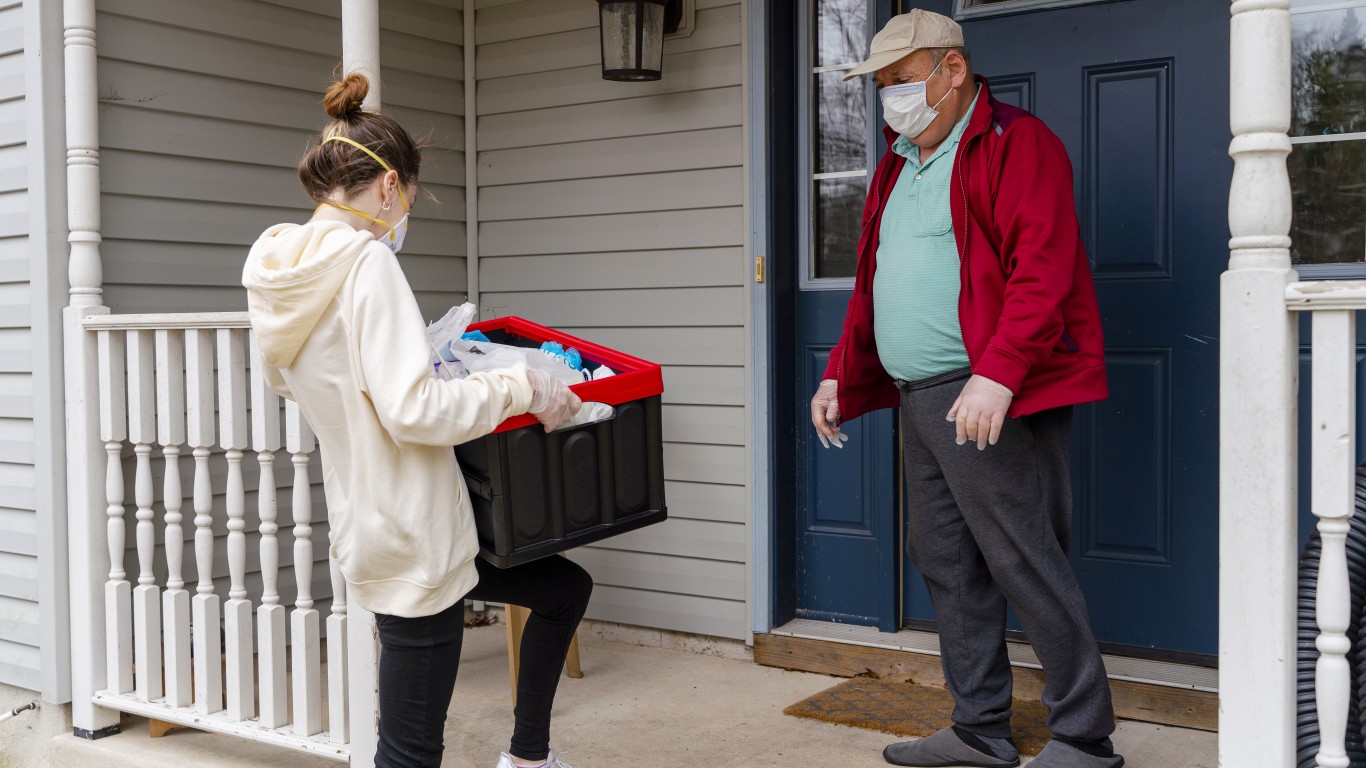
Pennsylvania
> Date of first social distancing order: Mar 16, 2020
> Time for cases to double before first social distancing orders: 6 days
> Total cases as of Mar 16, 2020: 81
> Time for cases to double 7 days after: 4 days
> Time for cases to double 14 days after: 5 days
> Time for cases to double 21 days after: 8 days
> Total COVID-19 cases as of Aug. 27: 1,024 per 100,000 people — 13th lowest (total: 131,156)
> Population: 12.8 million
Gov. Tom Wolf announced closure of the state’s public schools on March 13 that would take effect on March 16, the day the state issued its first social distancing order. The initial order for school closings was for 10 business days and was extended indefinitely on March 30. The social distancing order prohibited indoor gatherings of 25 people or more and restricted capacity for restaurants and gyms to 50% and just 25% for restaurants.
After a resurgence of COVID-19 cases in July, the state announced mitigation steps starting July 16 to control the outbreak, such limited occupancy at bars and restaurants to 25% capacity. The state updated travel guidance on July 24 that recommended people entering Pennsylvania from high-risk states self-quarantine for 14 days upon arrival.
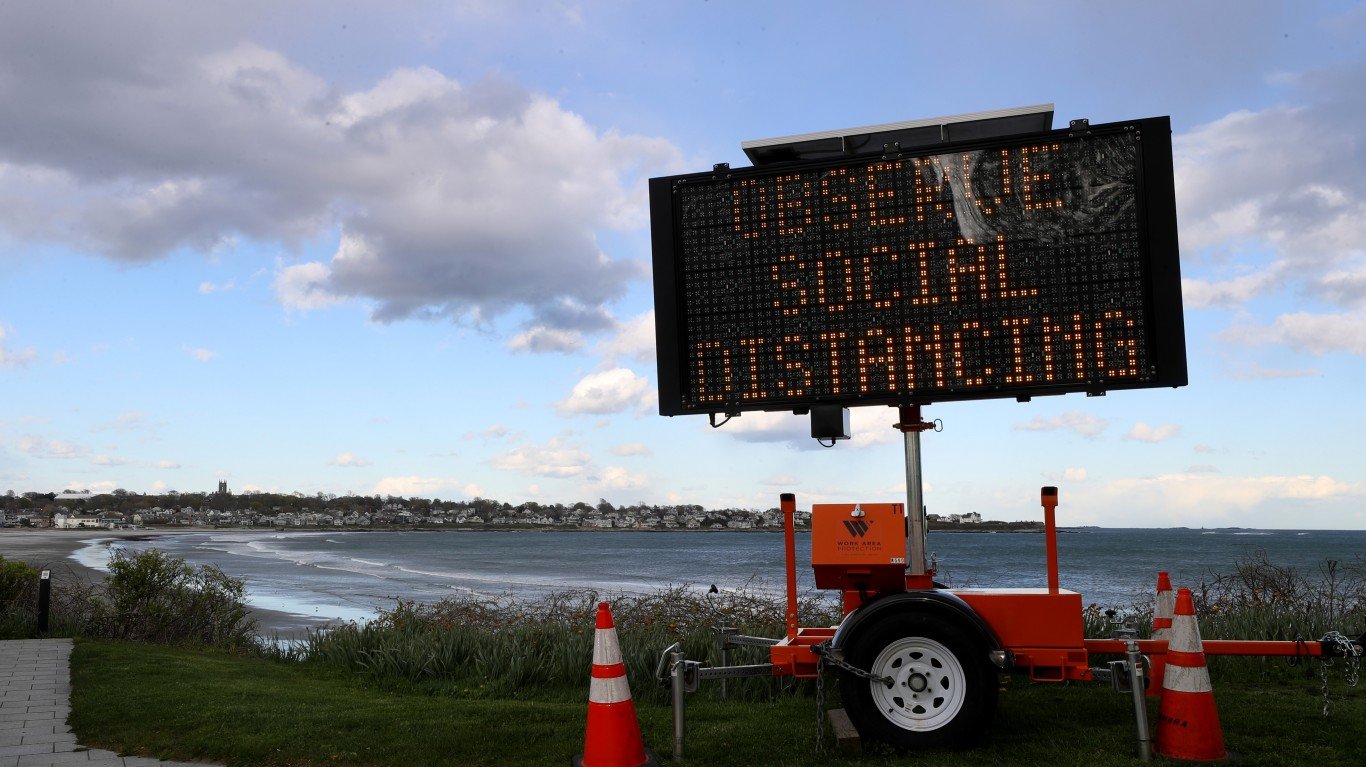
Rhode Island
> Date of first social distancing order: Mar 17, 2020
> Time for cases to double before first social distancing orders: 11 days
> Total cases as of Mar 17, 2020: 33
> Time for cases to double 7 days after: 6 days
> Time for cases to double 14 days after: 6 days
> Time for cases to double 21 days after: 8 days
> Total COVID-19 cases as of Aug. 27: 2,042 per 100,000 people — 13th highest (total: 21,589)
> Population: 1.1 million
On March 16, Rhode Island banned gatherings of 25 people or more and suspended food establishments from serving food or drinks on premises. In late March, the nation’s smallest state ordered anyone visiting Rhode Island to self-quarantine for 14 days to help stop the spread of the coronavirus.
An executive order from Gov. Gina Raimondo, effective May 8, ordered people to wear face coverings in indoor and outdoor public settings, unless they can maintain at least 6 feet between people. The state announced that restaurants can offer limited outdoor dining starting May 18.
[in-text-ad-2]

South Carolina
> Date of first social distancing order: Mar 16, 2020
> Time for cases to double before first social distancing orders: 6 days
> Total cases as of Mar 16, 2020: 33
> Time for cases to double 7 days after: 2 days
> Time for cases to double 14 days after: 6 days
> Time for cases to double 21 days after: 12 days
> Total COVID-19 cases as of Aug. 27: 2,254 per 100,000 people — 7th highest (total: 114,598)
> Population: 5.1 million
South Carolina closed all public schools on March 16, the same day the state issued its first social distancing order. All dine-in consumption of food and drink at restaurants or other food-service establishments was suspended starting on March 18.
Gov. Henry McMaster issued a statewide “home or work” order, effective April 7 that required South Carolina residents to remain “at home or work unless visiting family, exercising or obtaining essential goods or services.” The governor lifted the order on May 4.

South Dakota
> Date of first social distancing order: Mar 15, 2020
> Time for cases to double before first social distancing orders: N/A
> Total cases as of Mar 15, 2020: 9
> Time for cases to double 7 days after: 2 days
> Time for cases to double 14 days after: 4 days
> Time for cases to double 21 days after: 8 days
> Total COVID-19 cases as of Aug. 27: 1,382 per 100,000 people — 23rd lowest (total: 12,194)
> Population: 882,000
South Dakota is one of the few states that never issued a statewide lockdown order. More recently, about 70 COVID-19 cases in seven states in the West and Midwest have been linked to South Dakota’s Sturgis Motorcycle Rally, which drew more than 460,000 vehicles over a 10-day period in early August.
[in-text-ad]
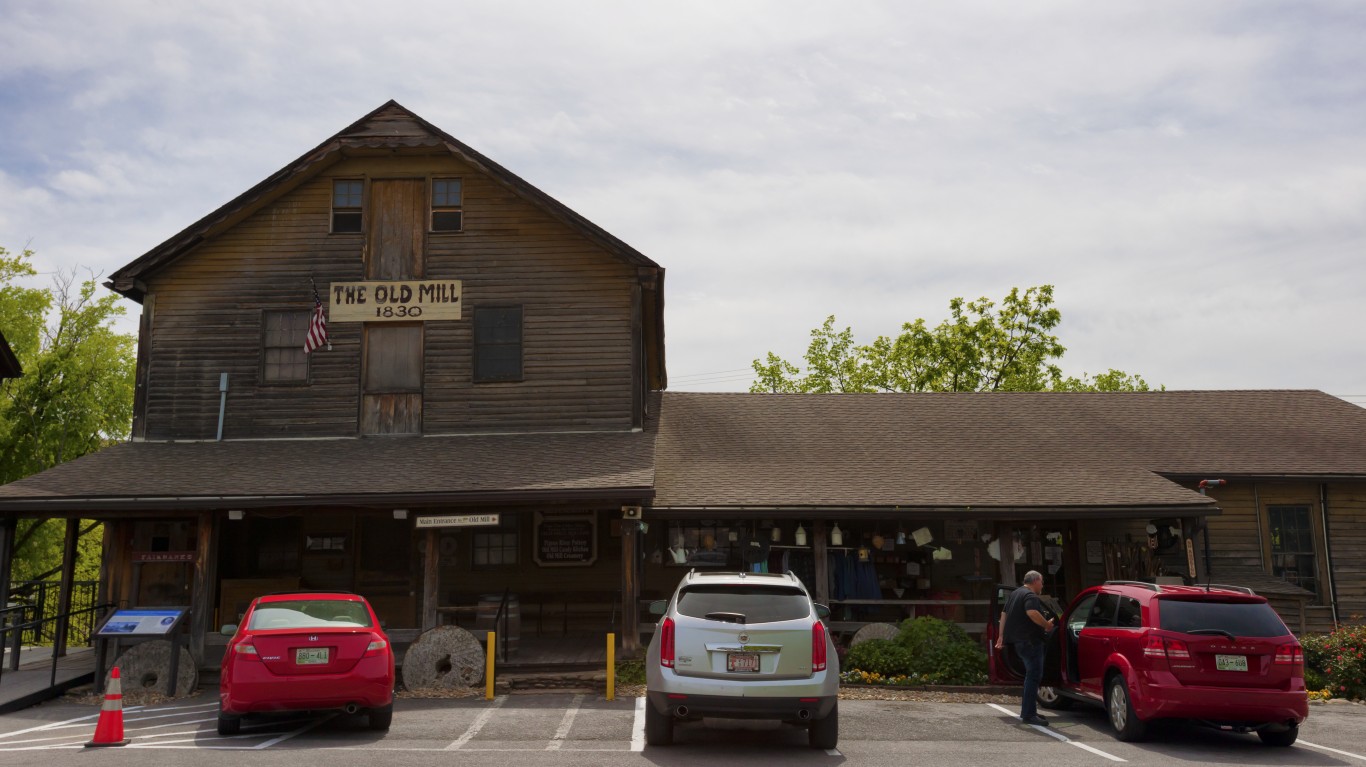
Tennessee
> Date of first social distancing order: Mar 20, 2020
> Time for cases to double before first social distancing orders: 2 days
> Total cases as of Mar 20, 2020: 237
> Time for cases to double 7 days after: 5 days
> Time for cases to double 14 days after: 18 days
> Time for cases to double 21 days after: 14 days
> Total COVID-19 cases as of Aug. 27: 2,204 per 100,000 people — 10th highest (total: 149,179)
> Population: 6.8 million
Tennessee’s first social distancing order encouraged people to work from home, avoid social gatherings of 10 people or more, avoid discretionary travel and social visits, and use drive-thru and pick-up options at restaurants, among other guidelines. The state identified its first case of COVID-19 on March 4.
Gov. Bill Lee issued a safer-at-home order that limited discretionary travel starting on March 31. That order was strengthened, requiring Tennesseeans to stay in place except for carrying out essential activities until April 30. Lee announced on April 20 that the most businesses in 89 of Tennessee’s 95 counties would be allowed to reopen beginning May 1. Also on May 1, gyms in most counties were allowed to reopen at 50% capacity, and most state parks could reopen.
Texas
> Date of first social distancing order: Mar 20, 2020
> Time for cases to double before first social distancing orders: 2 days
> Total cases as of Mar 20, 2020: 377
> Time for cases to double 7 days after: 4 days
> Time for cases to double 14 days after: 7 days
> Time for cases to double 21 days after: 13 days
> Total COVID-19 cases as of Aug. 27: 2,063 per 100,000 people — 12th highest (total: 592,137)
> Population: 28.7 million
Texas was among the last states to issue a social distancing order, doing so on March 20. In its first social distancing order, social gatherings of more than 10 people were banned. The order came a day after Gov. Greg Abbott proclaimed that COVID-19 posed an imminent threat of disaster for all the counties in Texas.
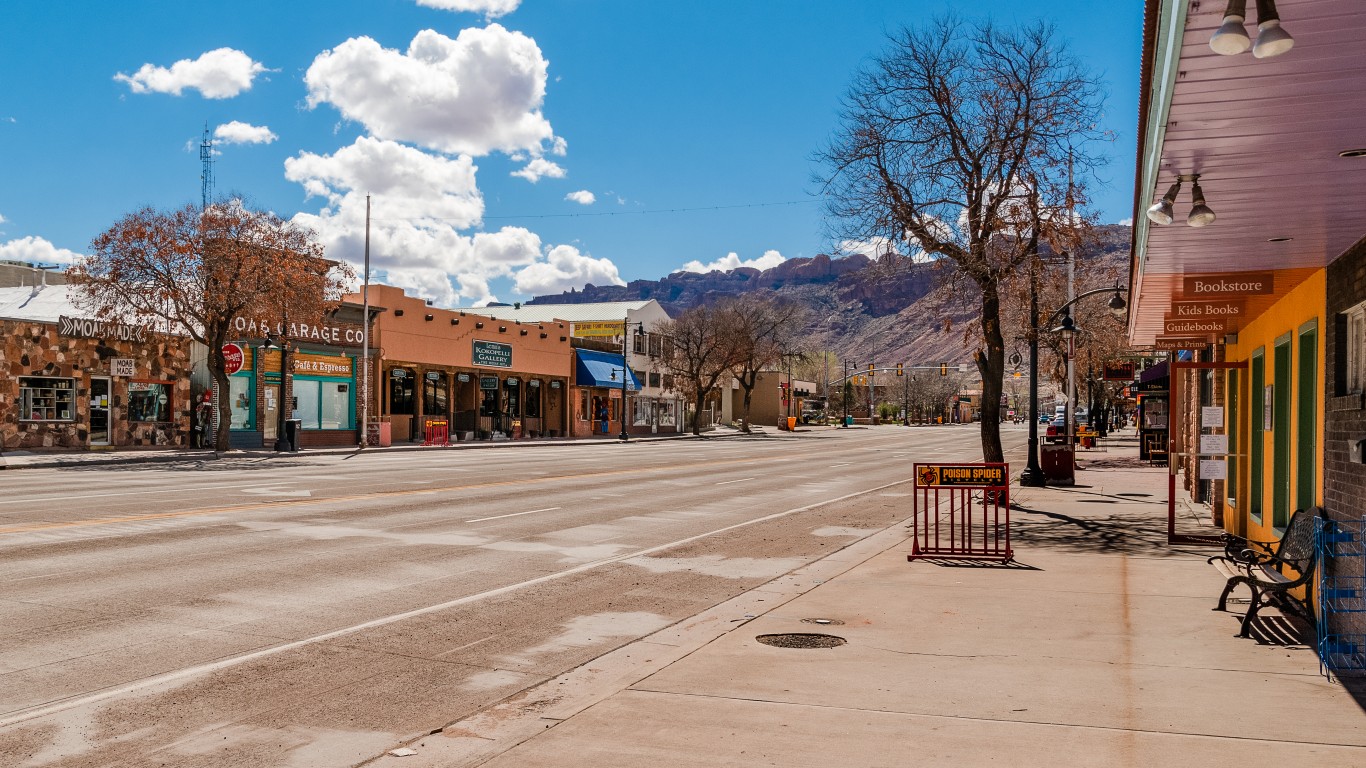
Utah
> Date of first social distancing order: Mar 16, 2020
> Time for cases to double before first social distancing orders: 3 days
> Total cases as of Mar 16, 2020: 40
> Time for cases to double 7 days after: 3 days
> Time for cases to double 14 days after: 9 days
> Time for cases to double 21 days after: 37 days
> Total COVID-19 cases as of Aug. 27: 1,599 per 100,000 people — 23rd highest (total: 50,557)
> Population: 3.2 million
Gov. Gary R. Herbert issued an order declaring a state of emergency on March 6 because of the novel coronavirus. A day after Utah issued its first social distancing directive on March 16, the Beehive State suspended dine-in service for all restaurants, bars, and food service establishments for two weeks.
[in-text-ad-2]
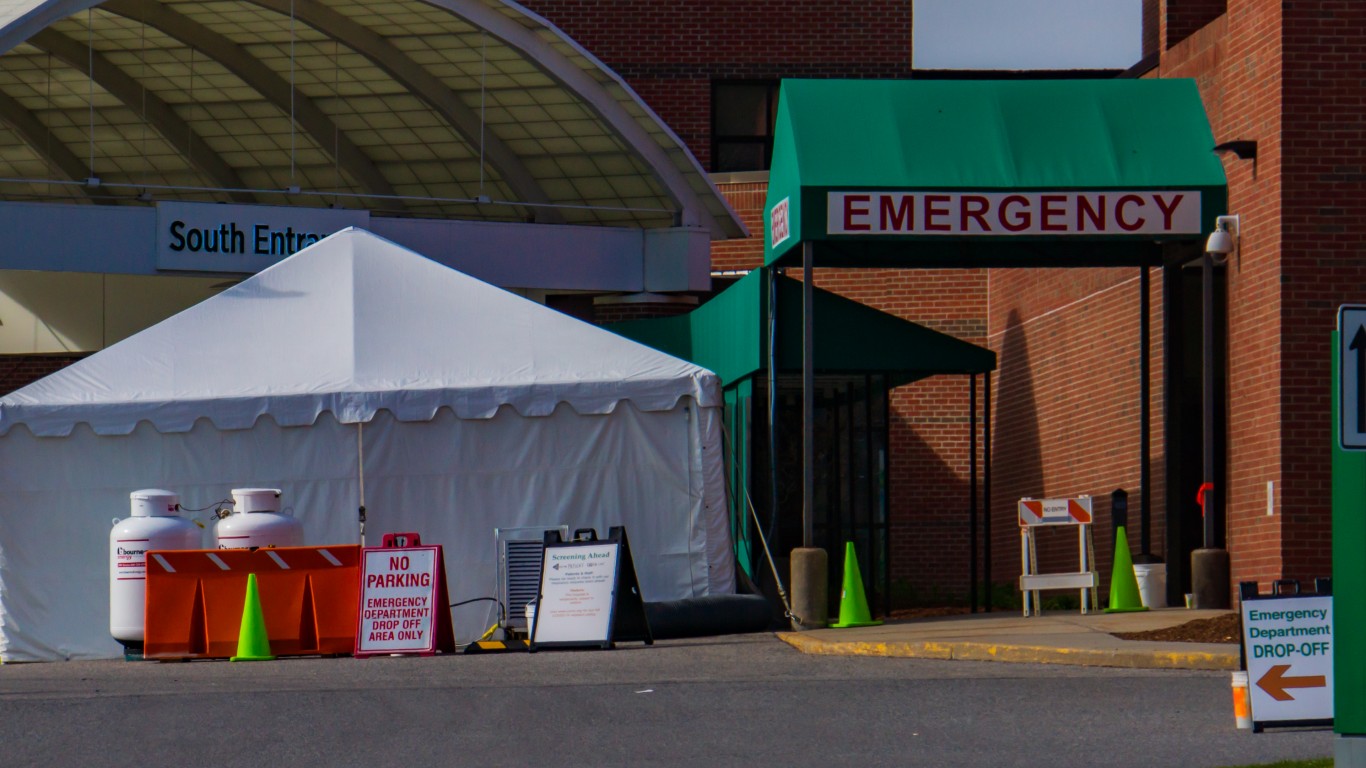
Vermont
> Date of first social distancing order: Mar 13, 2020
> Time for cases to double before first social distancing orders: N/A
> Total cases as of Mar 13, 2020: 2
> Time for cases to double 7 days after: 4 days
> Time for cases to double 14 days after: 7 days
> Time for cases to double 21 days after: 7 days
> Total COVID-19 cases as of Aug. 27: 253 per 100,000 people — the lowest (total: 1,586)
> Population: 626,000
Vermont reported its first two cases of COVID-19 on March 7 and March 11, and the state issued its first social distancing order on March 13 that forbade nonessential mass gatherings of more than 250 people in a single room or single area and prohibited people from visiting nursing homes. Gov. Phil Scott issued a “Stay Home, Stay Safe” order that went into effect on March 25.
Residents of Vermont were required to wear face coverings starting Aug. 1 whenever it is not possible to maintain 6 feet of distance from others outside.
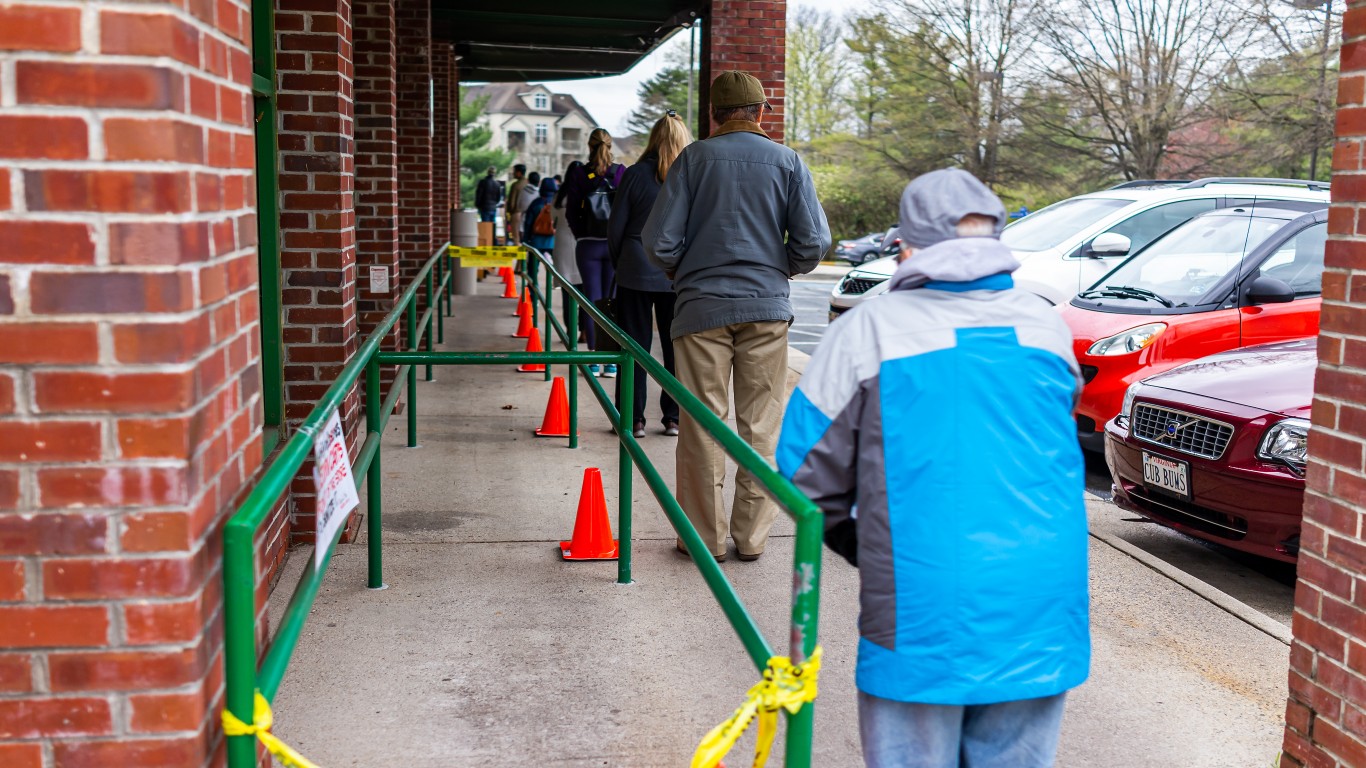
Virginia
> Date of first social distancing order: Mar 12, 2020
> Time for cases to double before first social distancing orders: 2 days
> Total cases as of Mar 12, 2020: 17
> Time for cases to double 7 days after: 5 days
> Time for cases to double 14 days after: 2 days
> Time for cases to double 21 days after: 8 days
> Total COVID-19 cases as of Aug. 27: 1,369 per 100,000 people — 21st lowest (total: 116,579)
> Population: 8.5 million
Virginia issued its first social distancing order on March 12, the same day Gov. Ralph Northam declared a state of emergency in the commonwealth and he issued a statewide stay-at-home order on March 30.
Virginia’s public beaches and racetracks were allowed to reopen on a limited basis beginning May 29. Most of Virginia moved to phase 2 of reopening on June 5, and social gathering restrictions were raised to 50 people from 10.
[in-text-ad]
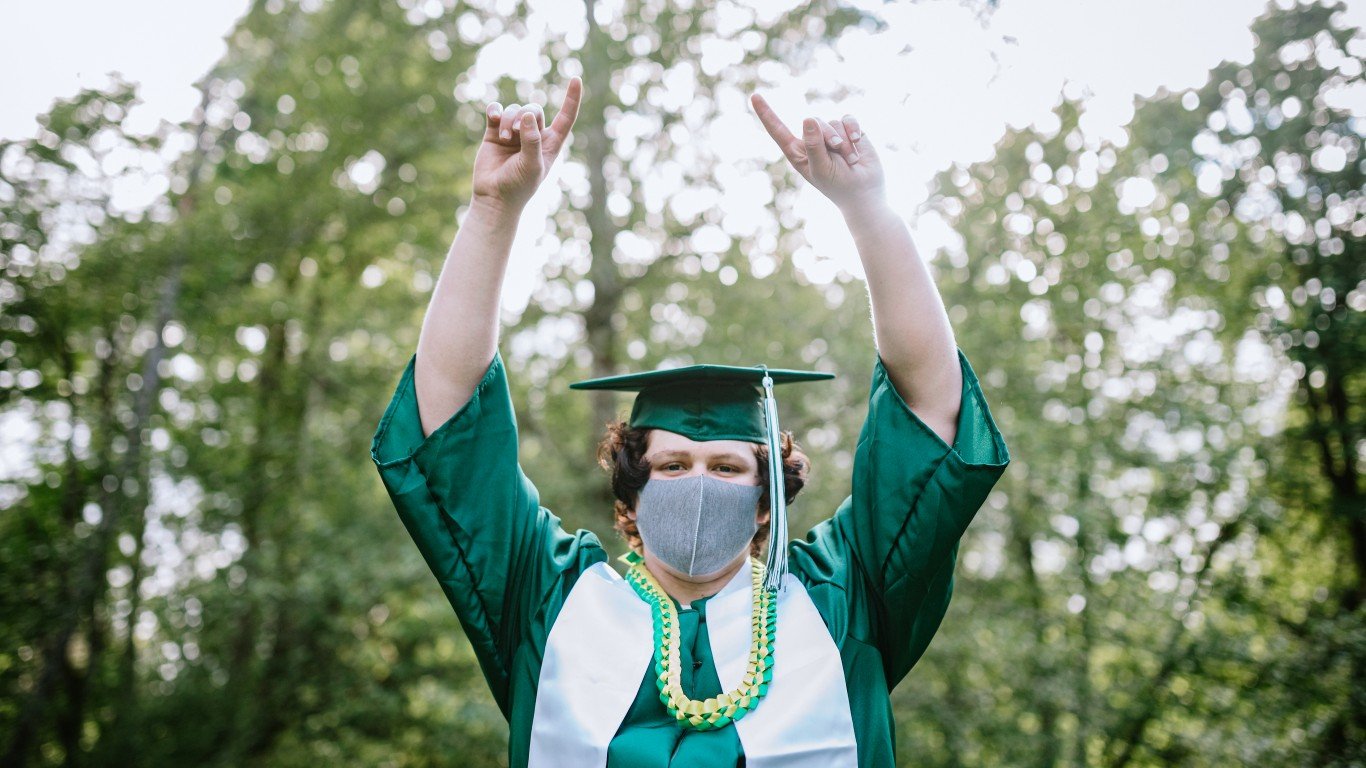
Washington
> Date of first social distancing order: Mar 10, 2020
> Time for cases to double before first social distancing orders: 2 days
> Total cases as of Mar 10, 2020: 279
> Time for cases to double 7 days after: 7 days
> Time for cases to double 14 days after: 6 days
> Time for cases to double 21 days after: 46 days
> Total COVID-19 cases as of Aug. 27: 958 per 100,000 people — 10th lowest (total: 72,161)
> Population: 7.5 million
Washington was the first state to issue social distancing orders, on March 10. The first confirmed case of COVID-19 in the United States was in Washington on Jan. 20.
Starting July 30, restaurants required parties to be members of the same household as a condition for eating indoors. Weddings and funeral ceremonies were permitted as of Aug. 6, but receptions were not.
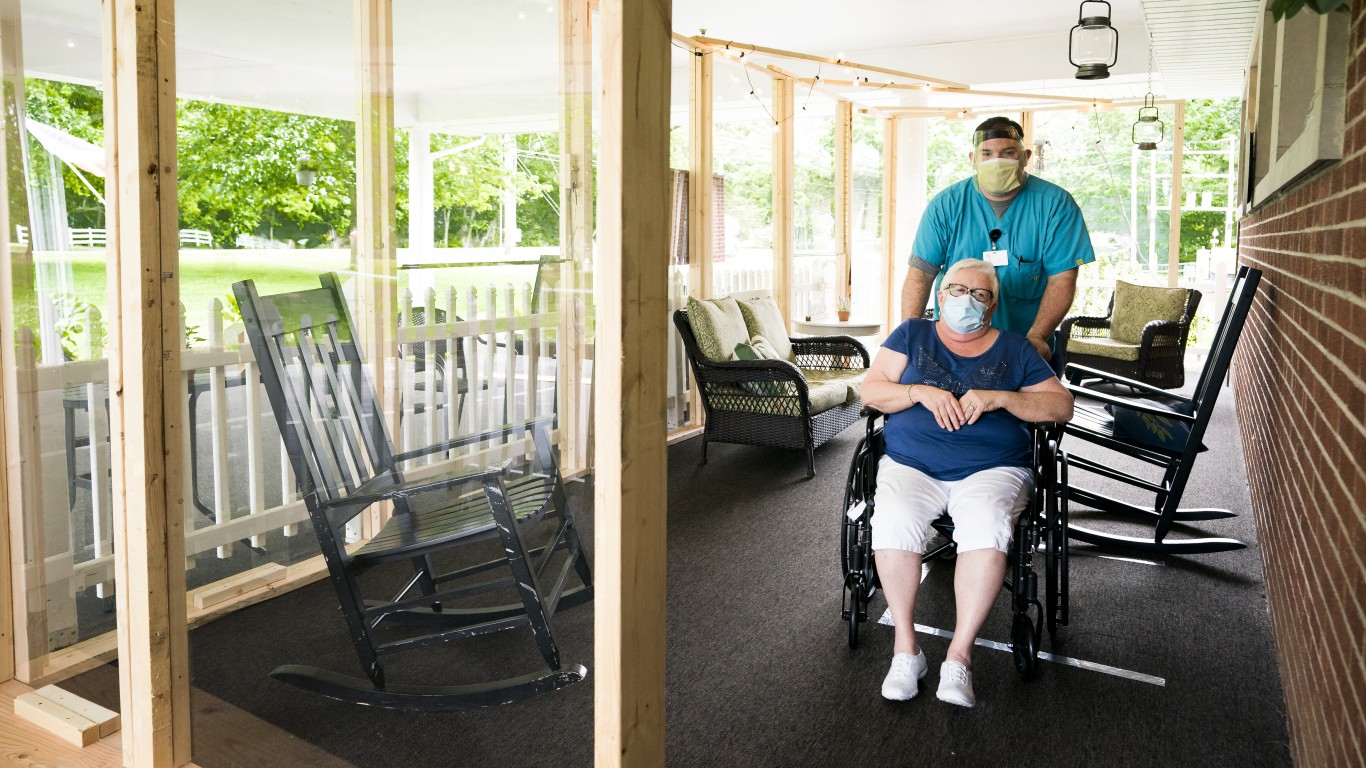
West Virginia
> Date of first social distancing order: Mar 13, 2020
> Time for cases to double before first social distancing orders: N/A
> Total cases as of Mar 13, 2020: 0
> Time for cases to double 7 days after: 0 days
> Time for cases to double 14 days after: 4 days
> Time for cases to double 21 days after: 9 days
> Total COVID-19 cases as of Aug. 27: 533 per 100,000 people — 5th lowest (total: 9,633)
> Population: 1.8 million
Gov. Jim Justice on March 13 ordered the closure of all West Virginia schools.At that time, West Virginia had yet to report its first case of COVID-19. Justice ordered restaurants and bars closed on March 17. A week later, he issued a stay-at-home order, effective March 24, that required West Virginians to remain at home and limit movements outside of their homes beyond essential needs.
Summer youth camps were allowed to resume on June 22. On June 25, the state lowered the limit on social gatherings to 25 people from 100. Fairs and festivals in West Virginia were permitted to open, with restrictions, starting July 1. Open-air concerts also were allowed to resume on July 1.
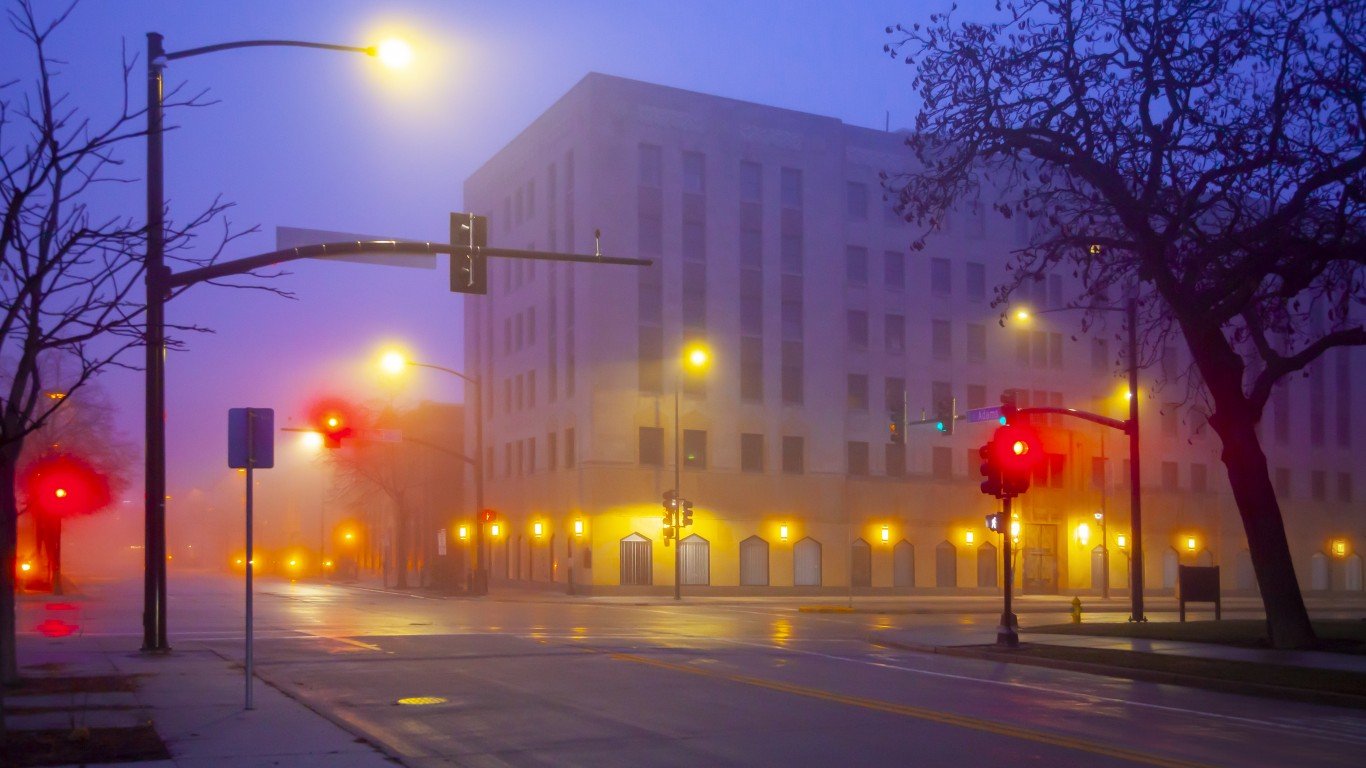
Wisconsin
> Date of first social distancing order: Mar 17, 2020
> Time for cases to double before first social distancing orders: 2 days
> Total cases as of Mar 17, 2020: 72
> Time for cases to double 7 days after: 7 days
> Time for cases to double 14 days after: 16 days
> Time for cases to double 21 days after: 18 days
> Total COVID-19 cases as of Aug. 27: 1,258 per 100,000 people — 17th lowest (total: 73,138)
> Population: 5.8 million
Wisconsin Gov. Tony Evers ordered all public schools to close on March 18, a day after social gatherings were limited to 50 people in a single room. The order to close schools took effect on March 18. The governor extended the statewide stay-at-home order through. A statewide order mandating people wear face coverings while indoors and not in a private residence went into effect on Aug. 1.
[in-text-ad-2]
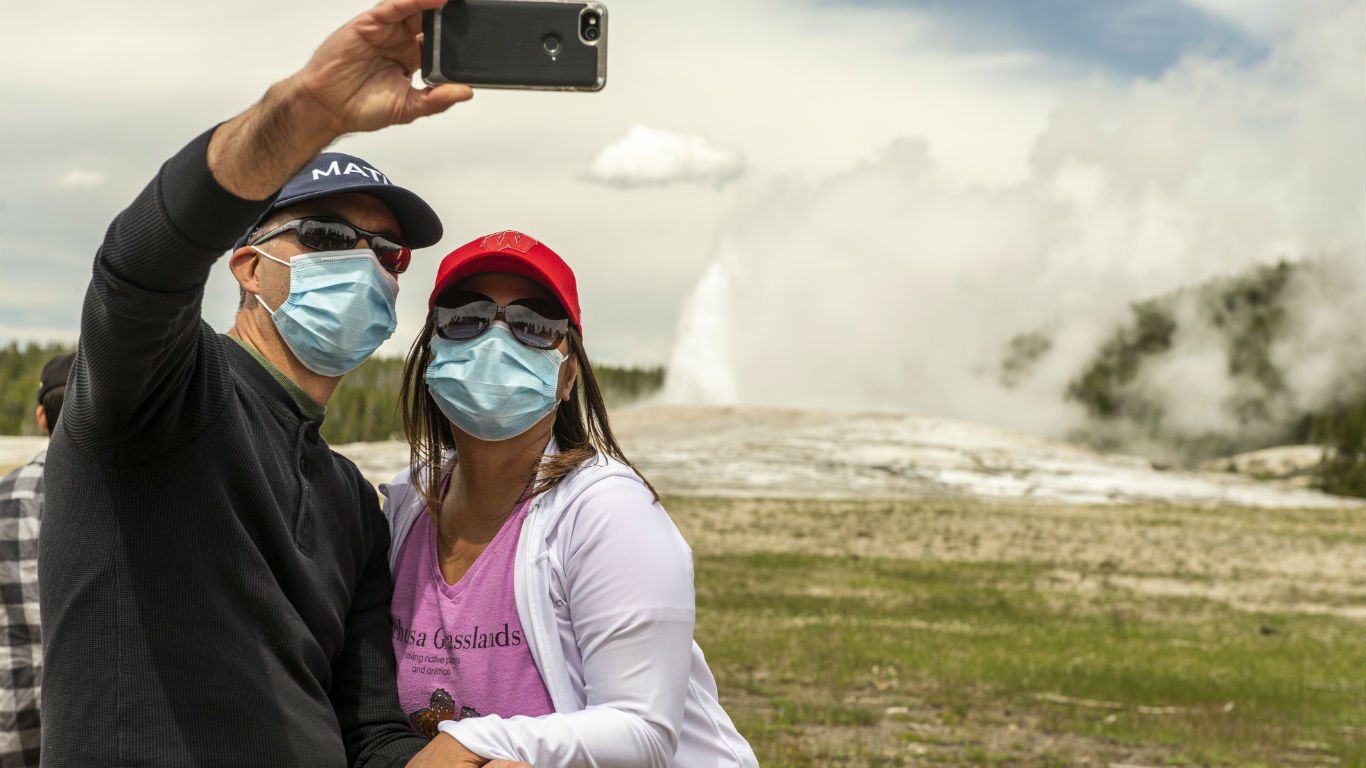
Wyoming
> Date of first social distancing order: Mar 19, 2020
> Time for cases to double before first social distancing orders: 18 days
> Total cases as of Mar 19, 2020: 18
> Time for cases to double 7 days after: 7 days
> Time for cases to double 14 days after: 9 days
> Time for cases to double 21 days after: 4 days
> Total COVID-19 cases as of Aug. 27: 644 per 100,000 people — 7th lowest (total: 3,722)
> Population: 578,000
Wyoming, the least populous of the 50 states, did not issue a social distancing order until March 19, and it was one of the last states to do so. Wyoming was one of seven states that did not issue orders requiring residents to stay at home from nonessential activities in March and April.
Gov. Mark Gordon on Aug. 12 updated orders regarding outdoor public gatherings, permitting the gathering of up to 1,000 people or 50% of a venue’s capacity after Aug.16.
Methodology
To identify each state’s outbreak before and after social distancing, 24/7 Wall St. reviewed data compiled in the Aug. 11, 2020 study: “Social distancing to slow the US COVID-19 epidemic: Longitudinal pretest–posttest comparison group study,” by researchers Mark J. Siedner, Guy Harling, Zahra Reynolds, Rebecca F. Gilbert, Sebastien Haneuse, Atheendar S. Venkataramani, Alexander C. Tsai.
The researchers compared the rate of change in daily COVID-19 cases before and 7, 14, and 21 days after each state’s first social distancing measure (closure of schools, closure of workplaces, cancellation of public events, restrictions on internal travel, or closure of state borders). Analysis was restricted to days on which a state had at least 30 cumulative cases reported to minimize any effects of volatile rate changes early in the epidemic. The rate of change in daily COVID-19 cases is expressed in the number of days it would take for the total cases to double. We included for each state the population-adjusted latest available COVID-19 confirmed case totals.
Sponsored: Want to Retire Early? Here’s a Great First Step
Want retirement to come a few years earlier than you’d planned? Or are you ready to retire now, but want an extra set of eyes on your finances?
Now you can speak with up to 3 financial experts in your area for FREE. By simply clicking here you can begin to match with financial professionals who can help you build your plan to retire early. And the best part? The first conversation with them is free.
Click here to match with up to 3 financial pros who would be excited to help you make financial decisions.
Thank you for reading! Have some feedback for us?
Contact the 24/7 Wall St. editorial team.
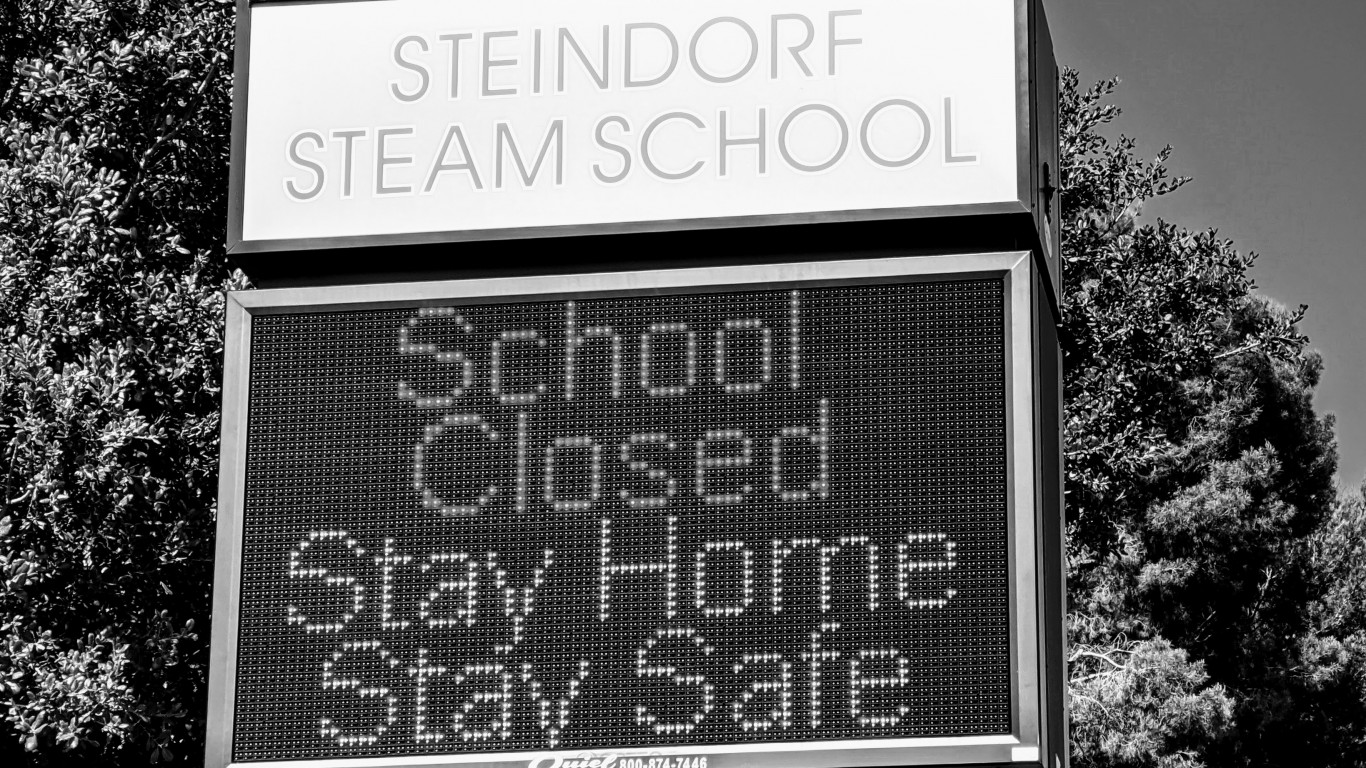
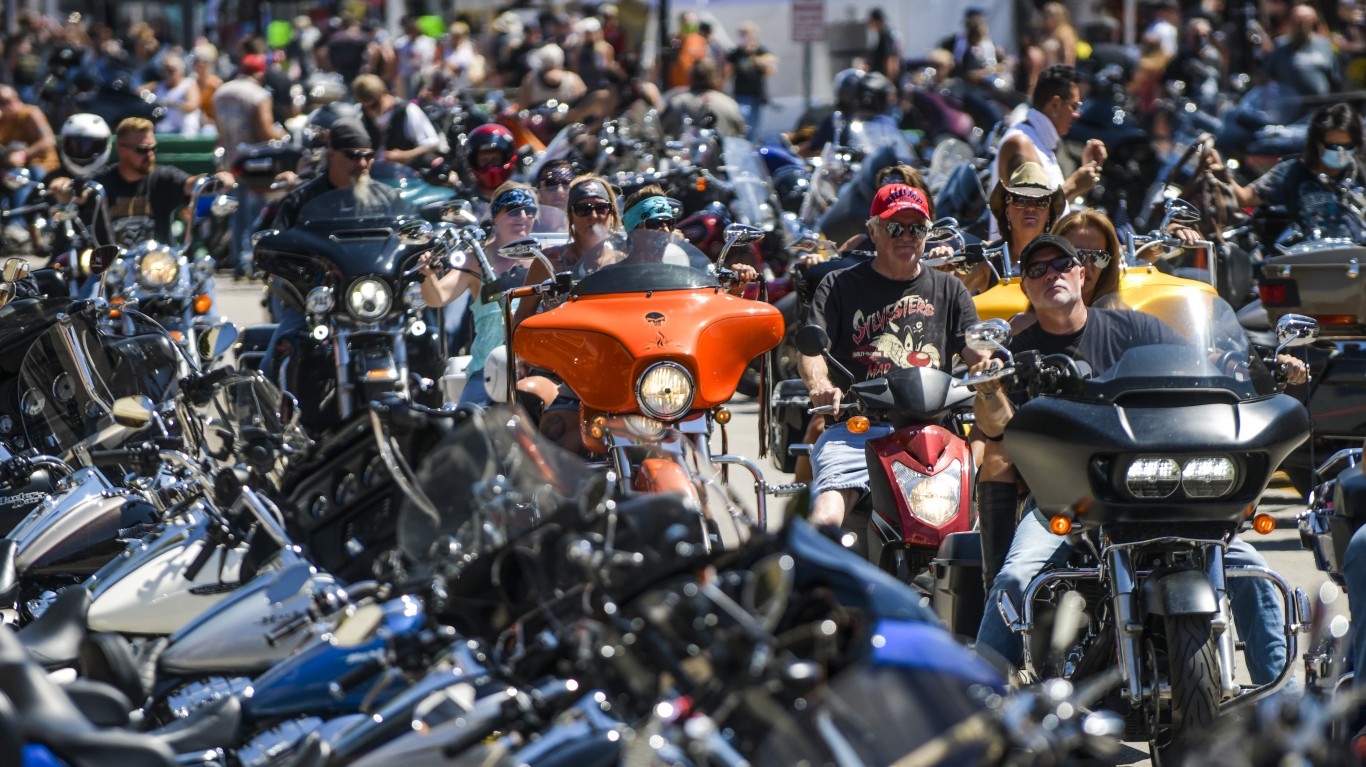 24/7 Wall St.
24/7 Wall St.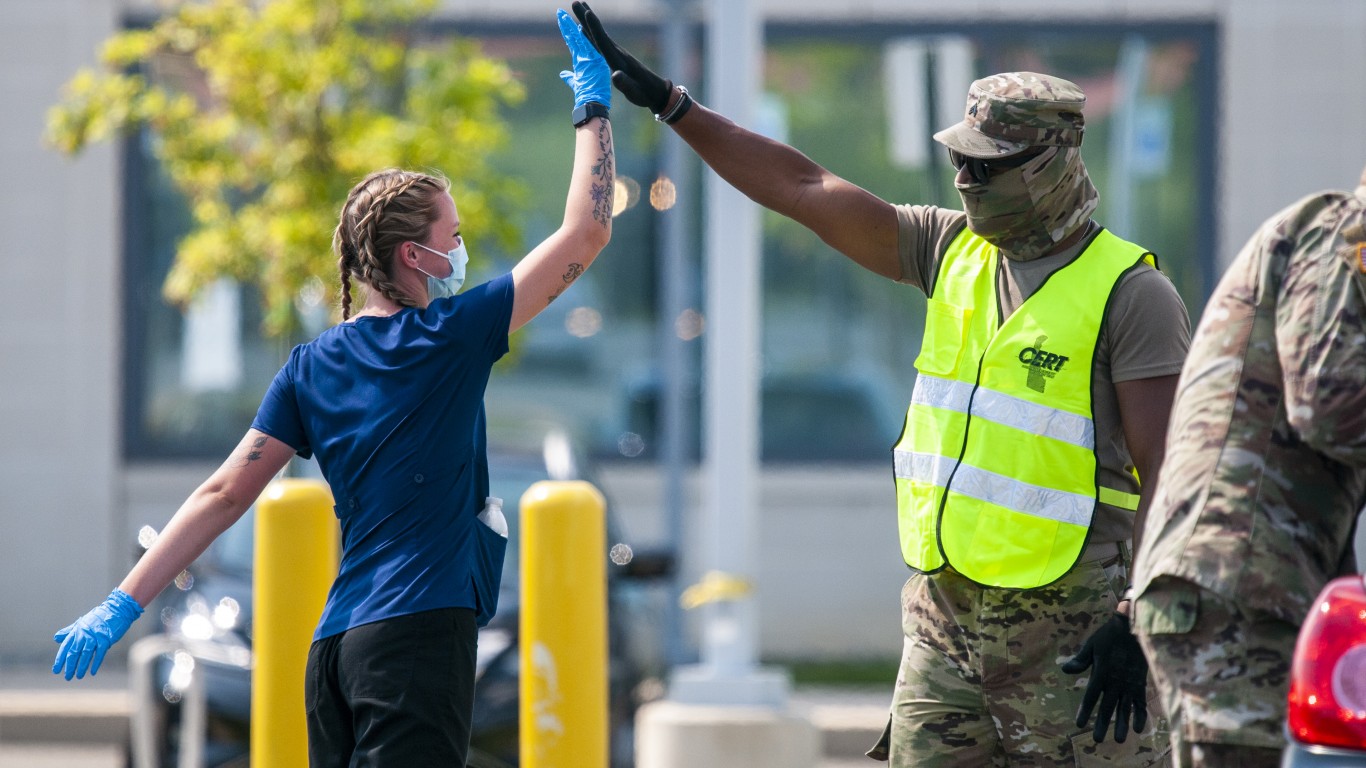
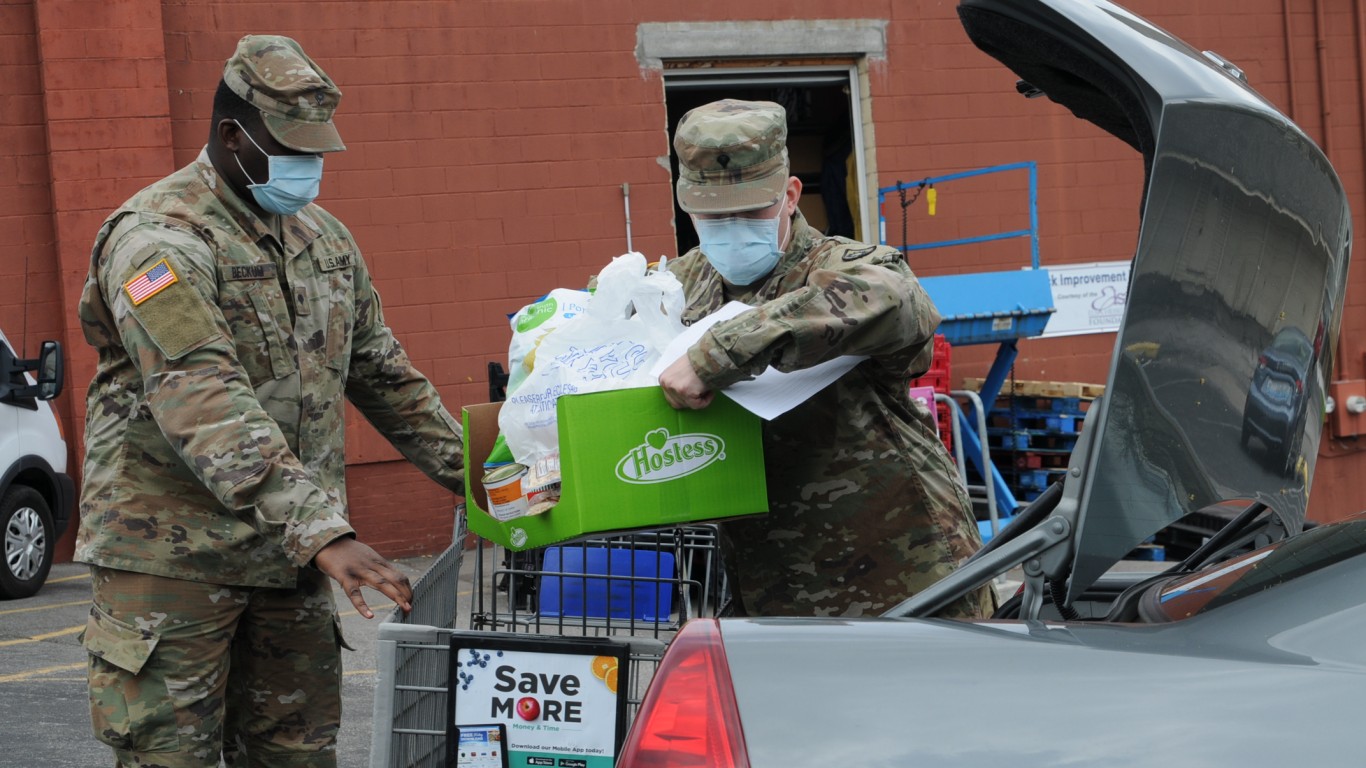
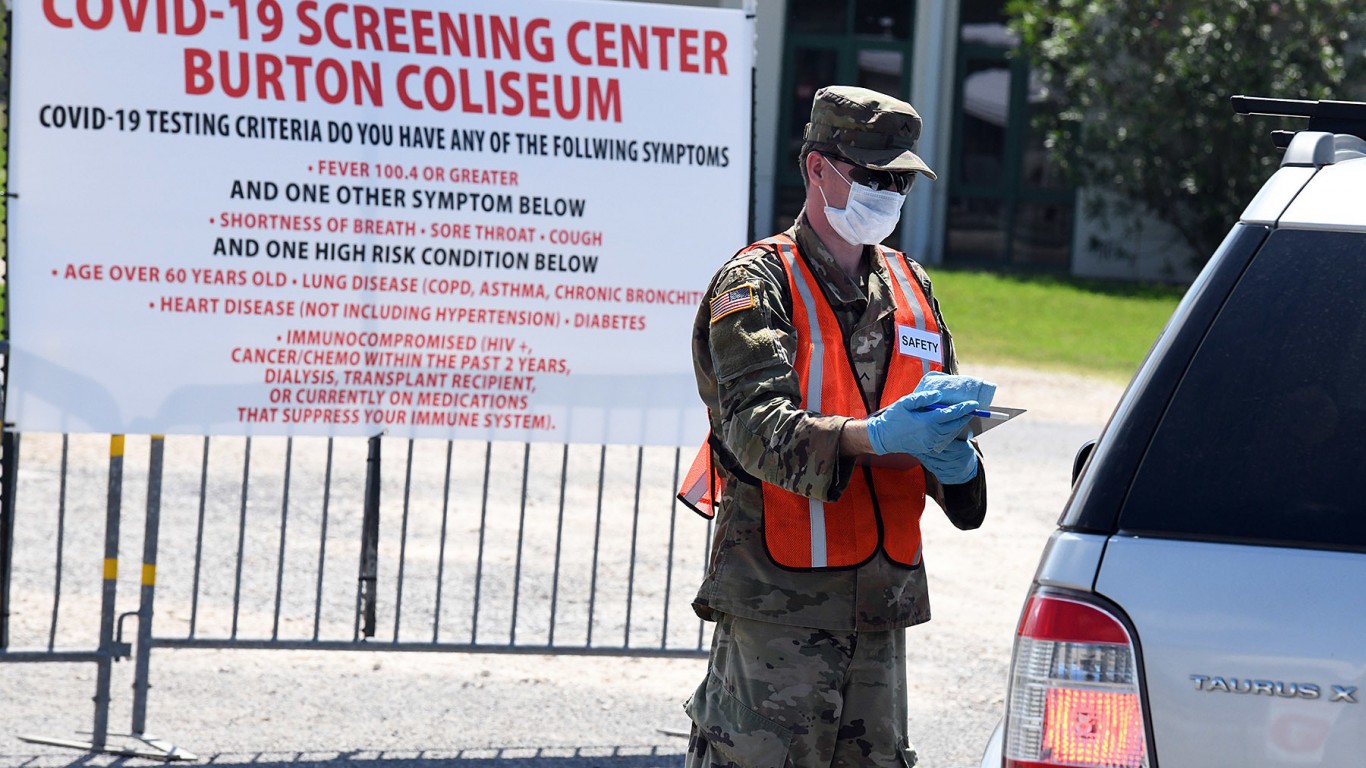
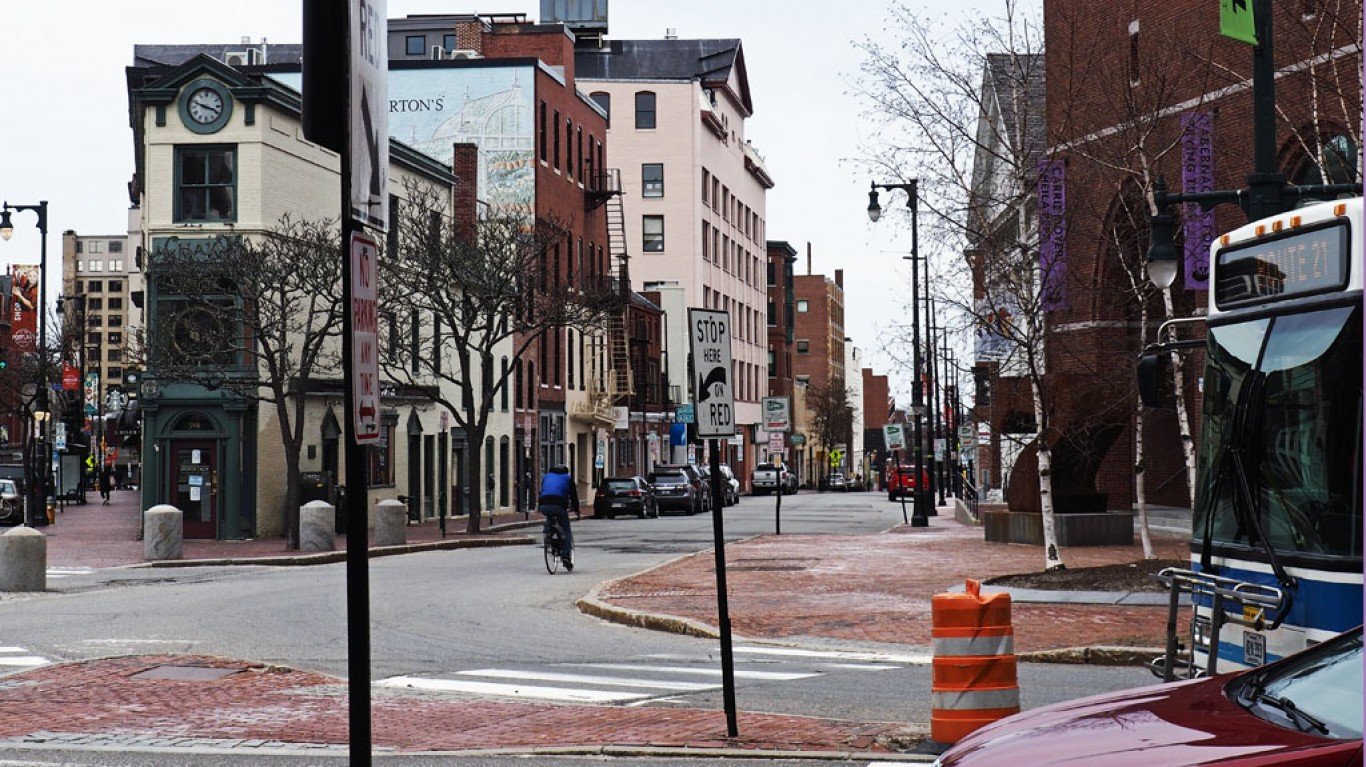
 24/7 Wall St.
24/7 Wall St.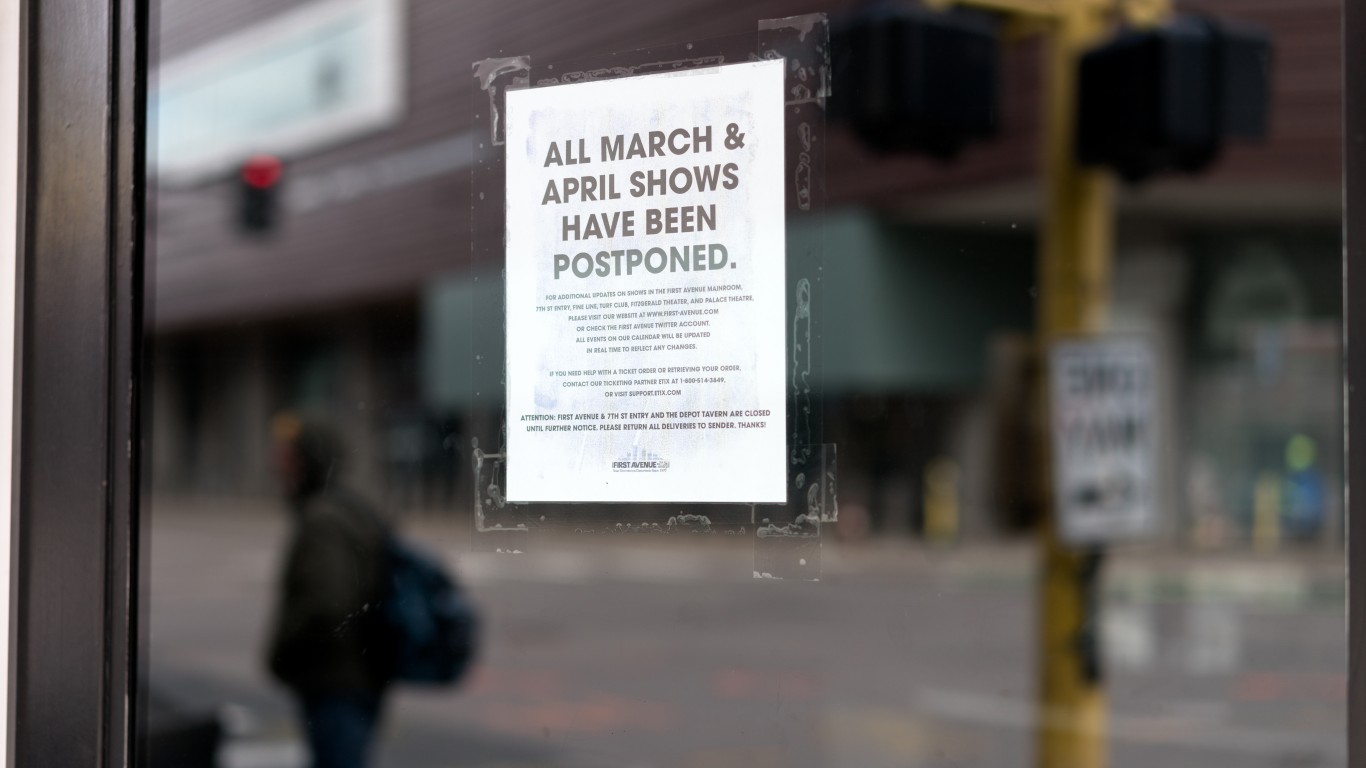
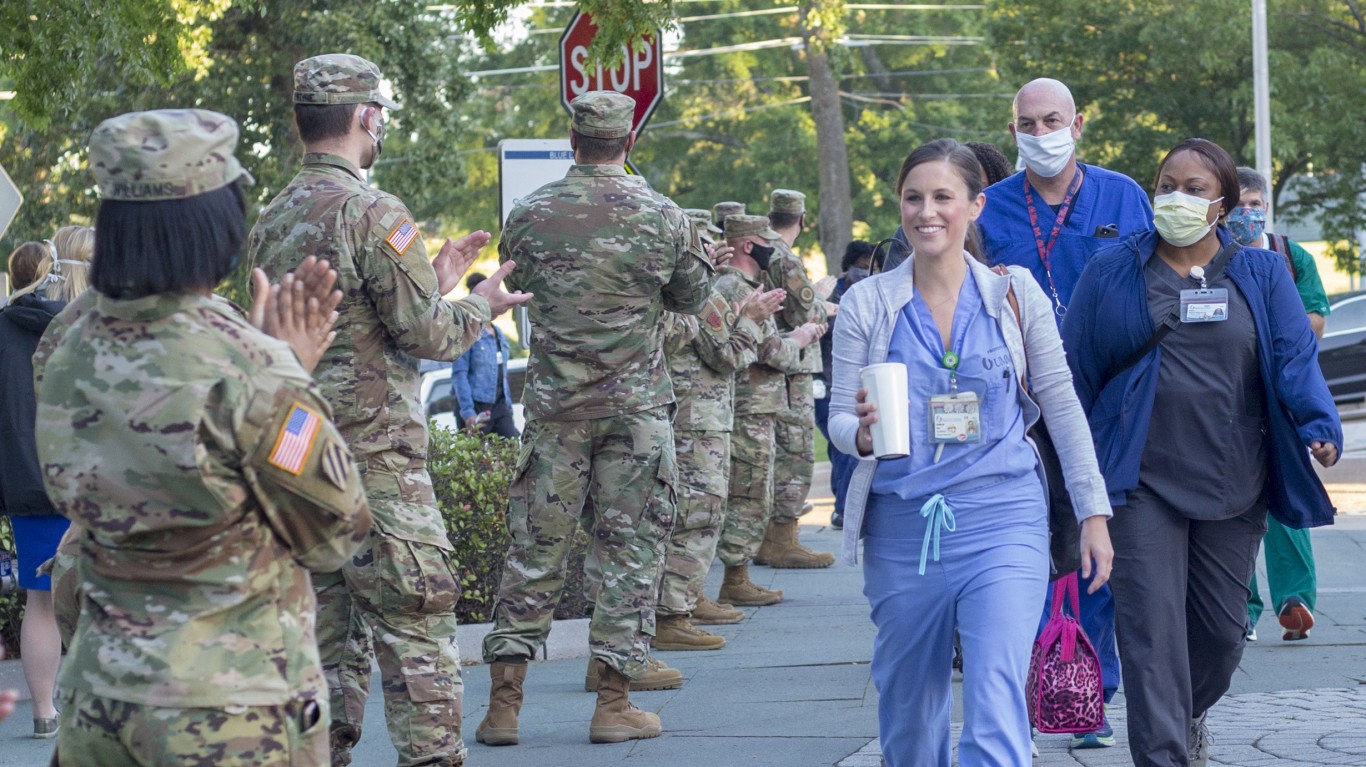
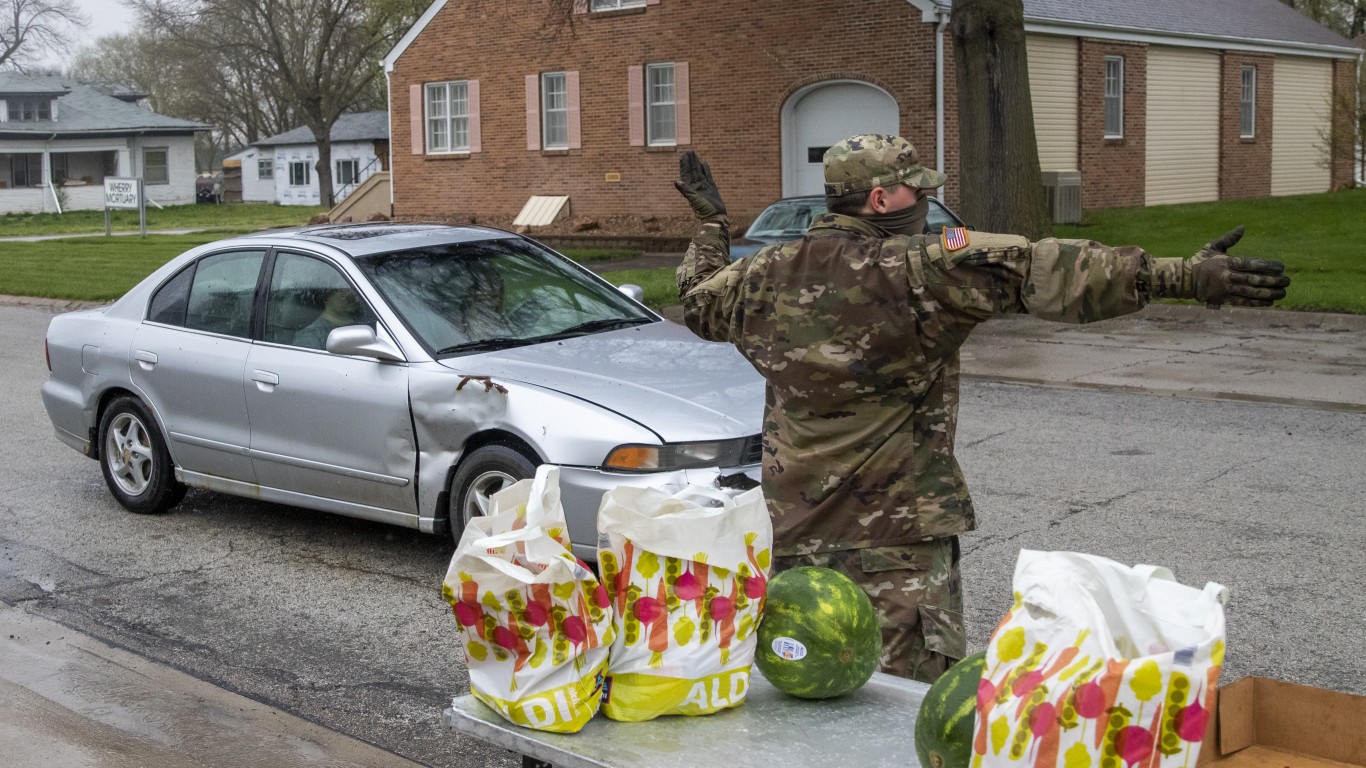
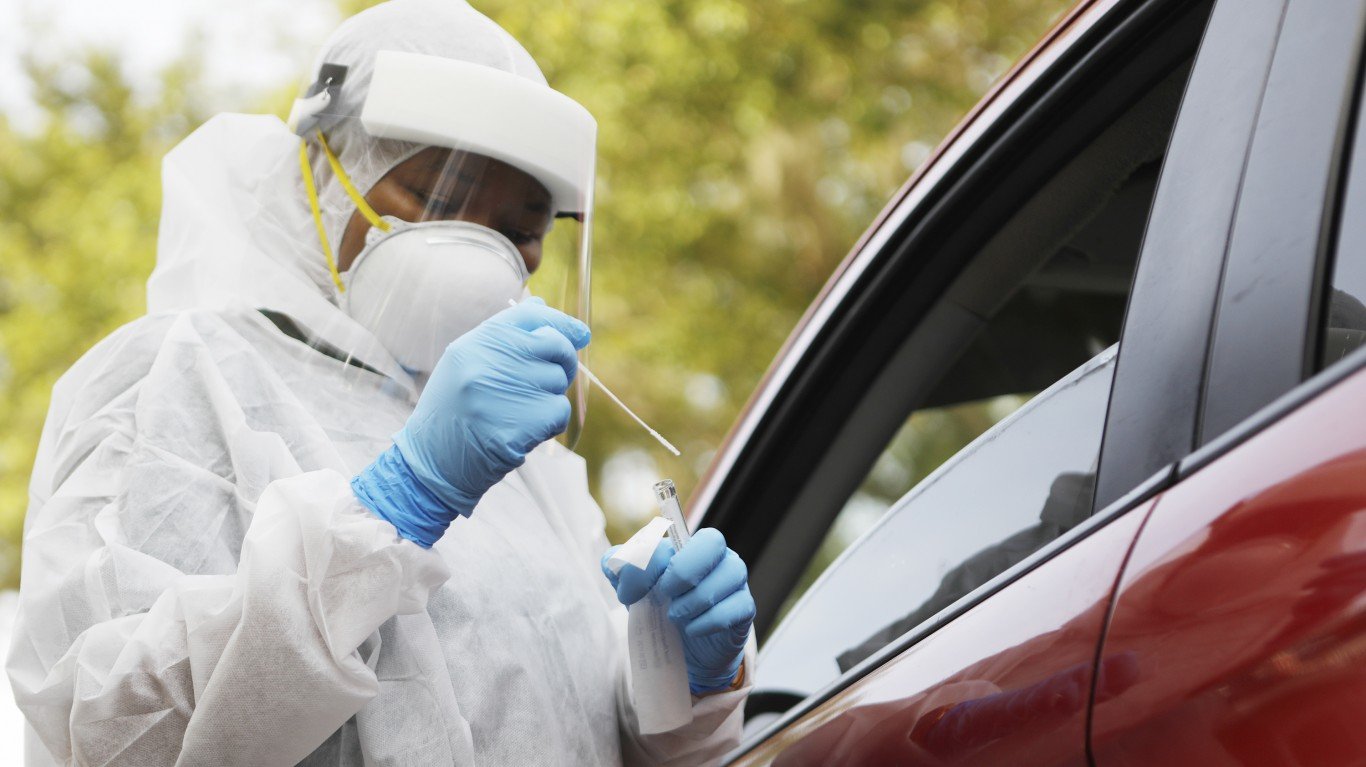 24/7 Wall St.
24/7 Wall St.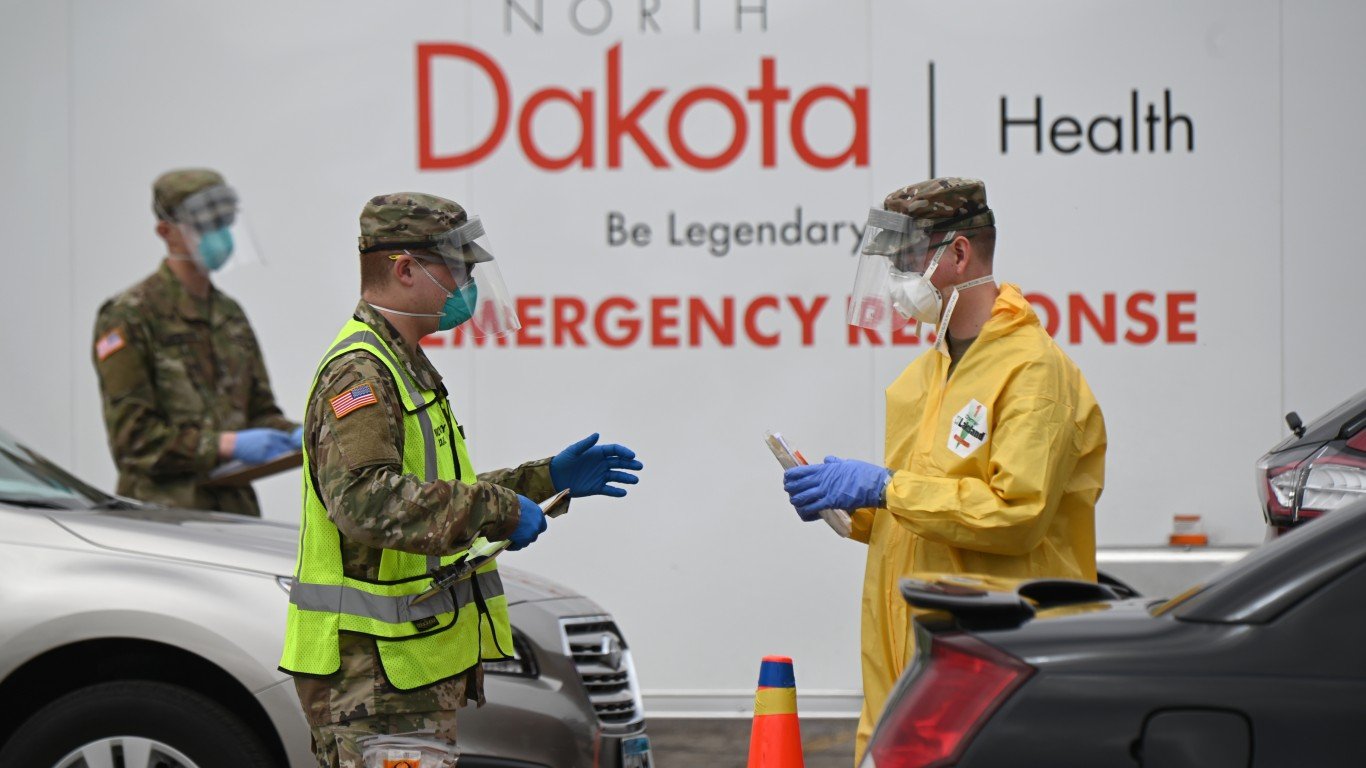
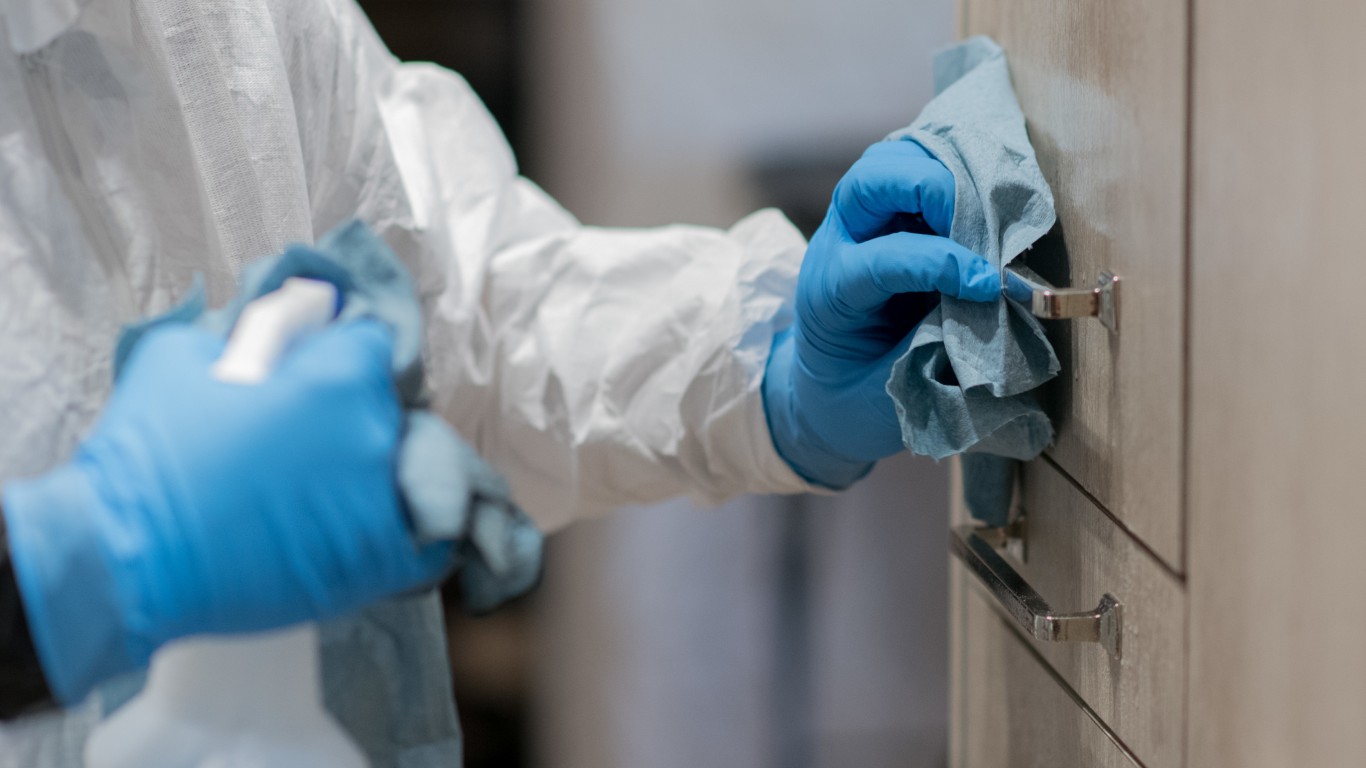
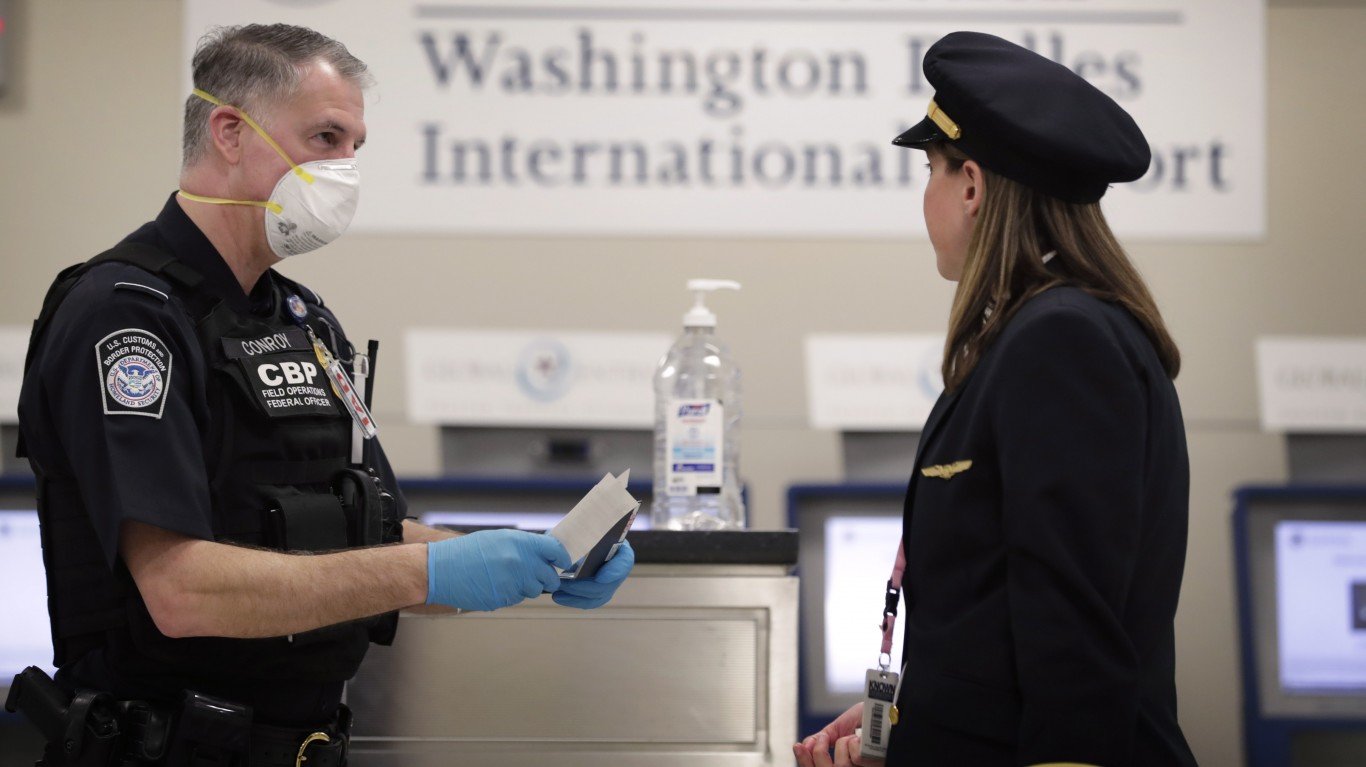 24/7 Wall St.
24/7 Wall St.
 24/7 Wall St.
24/7 Wall St.


